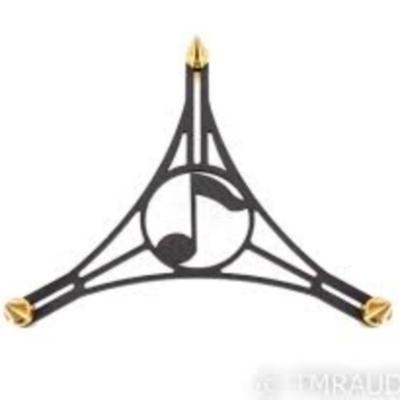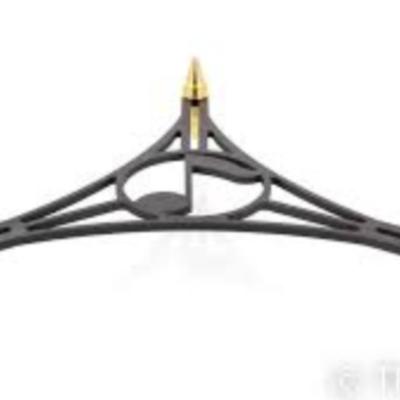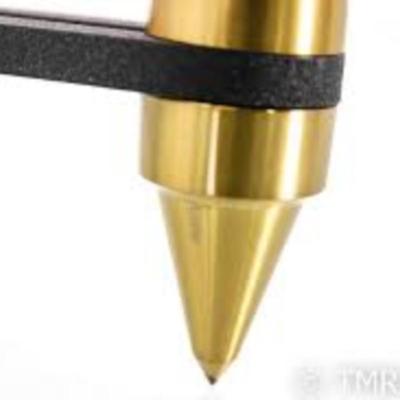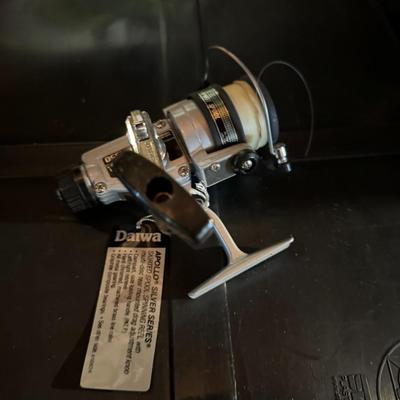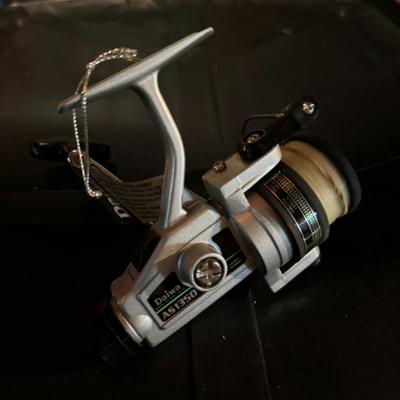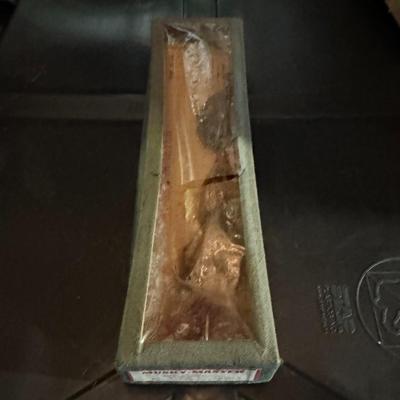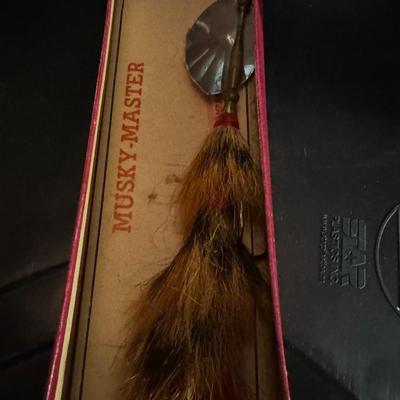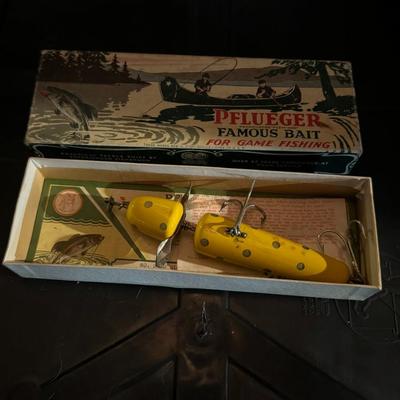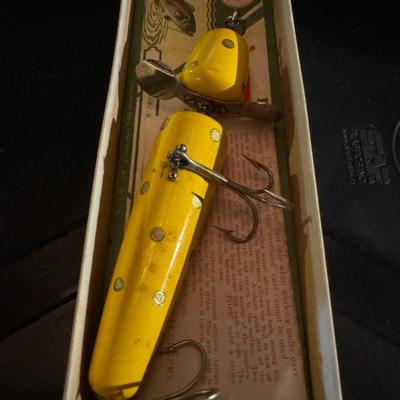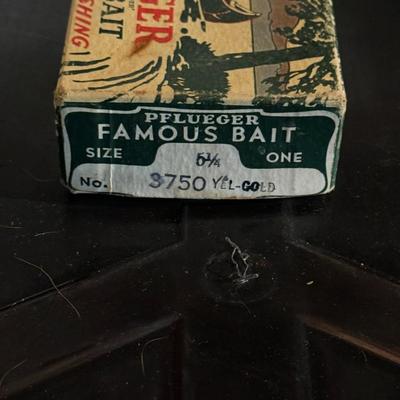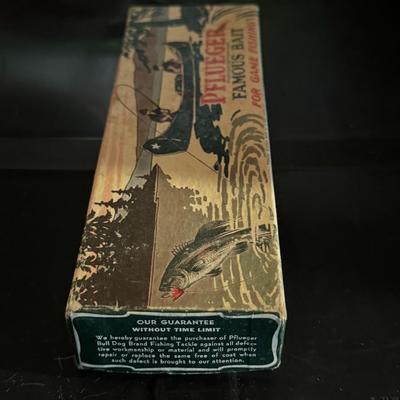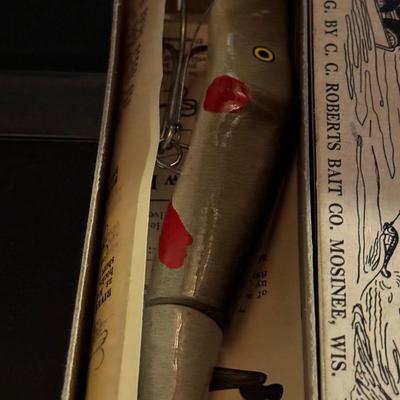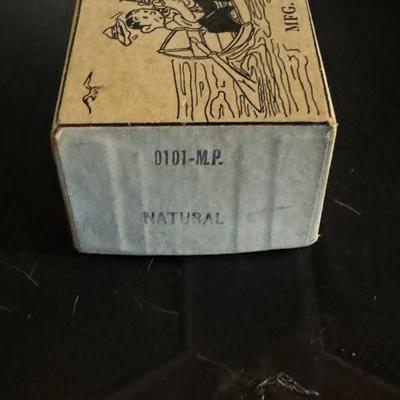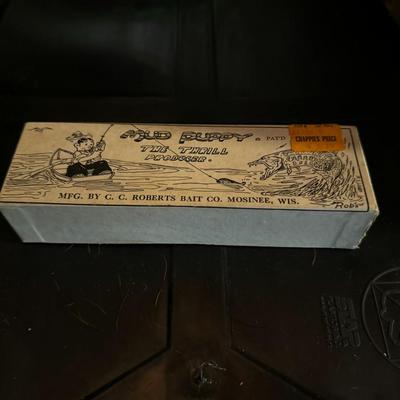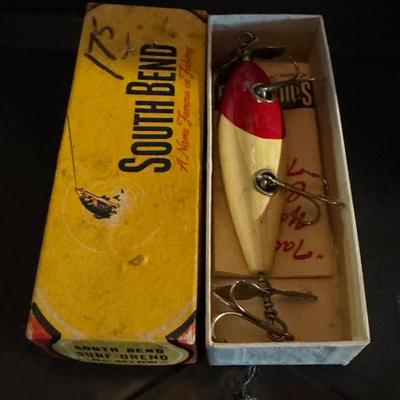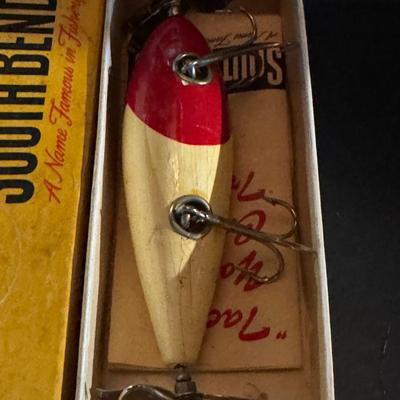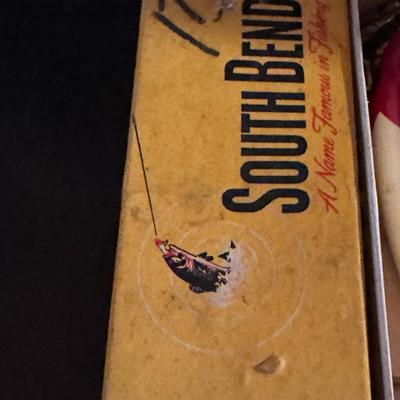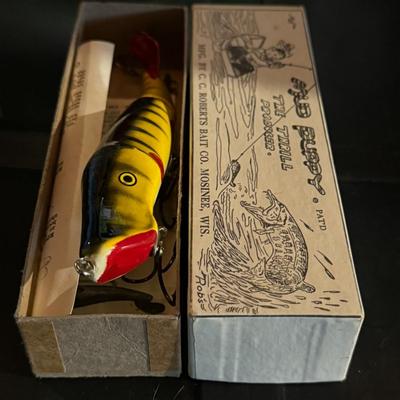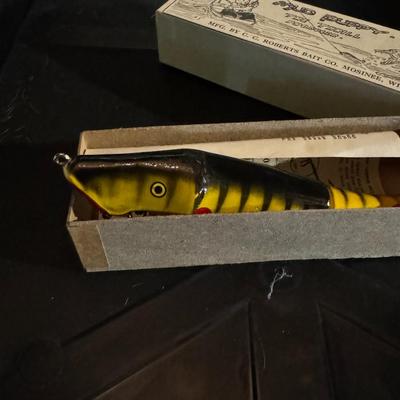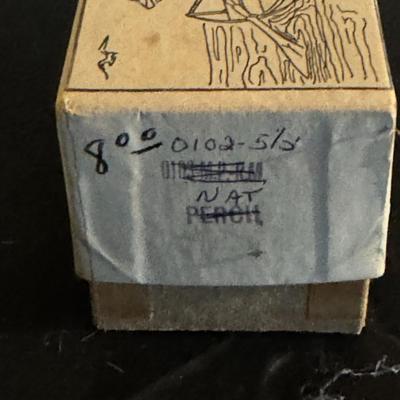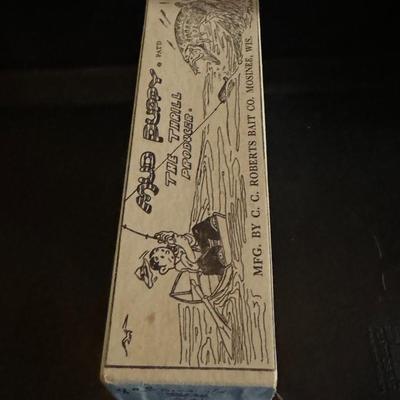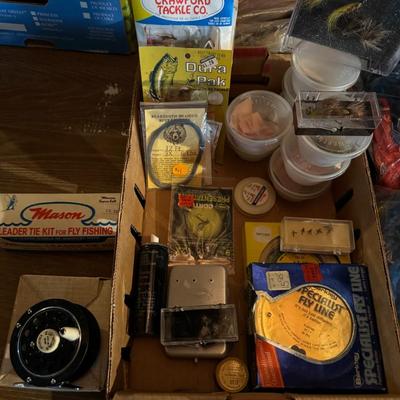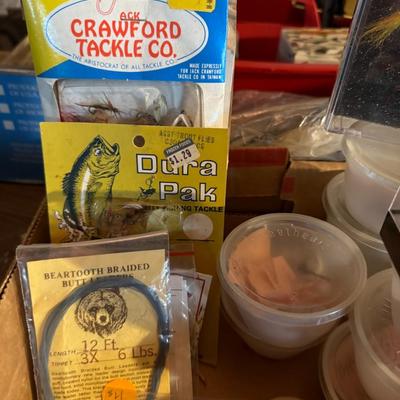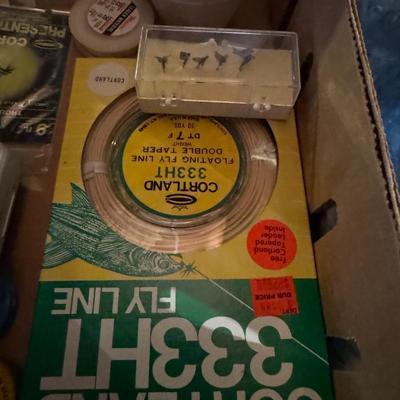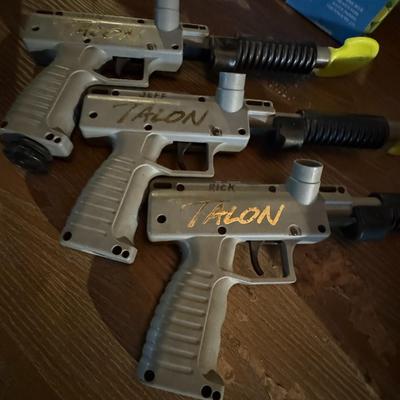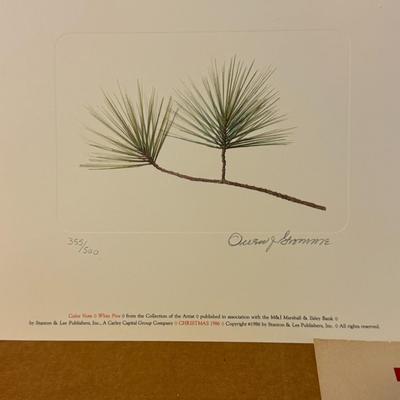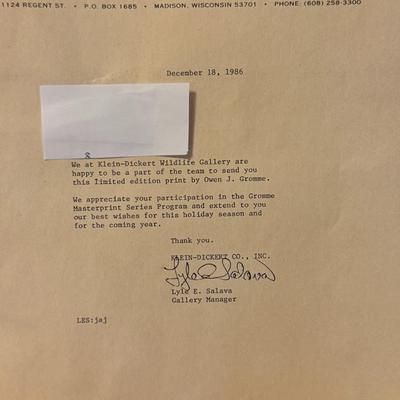-

EgglestonWorks Andra Center Speaker Single owner and proffesionally cared for. Near to new as you can get. Colour : The black Dimensions, mm : 393 x 457 x 380 Weight, kg : 24.8 Main characteristics Sensitivity, : dB 87 Resistance, : Ohm 8 Frequency range, : Hz - kHz 78 - 24 Colour : The black Dimensions, mm : 393 x 457 x 380 Weight, kg : 24.8 It's always tough to follow an award-winning act. Wes Phillips raved about the original EgglestonWorks Andra back in October 1997, and it was subsequently dubbed Stereophile's Speaker of the Year for 1997. The Andra won many other plaudits, and found its way into a number of top-shelf recording studios as the monitor of choice. Such a reputation for excellence is the stuff most speaker designers dream of. It also imposes the burden of expectation—the "new and improved" version of such a knockout product had better be good, or else. Since the Andra's debut in Stereophile there have been big changes at EgglestonWorks. While too complex to detail here, the end result is that the company is now under the resolute leadership of president Michael Sabre and director of sales and marketing Jim Thompson, but remains in its tradition-rich home of Memphis, Tennessee. When Sabre and Thompson determined that the time was ripe for updating the Andra, they didn't have far to look for inspiration. After Sabre assumed control of the company, EW developed their titanic Ivy Reference in collaboration with mastering legend Bob Ludwig, for use as Ludwig's reference at Gateway Mastering. The Ivy was then translated into the only slightly less imposing Savoy. The lofty ambitions of the Andra II project were to make significant and meaningful improvements to the Andra, ladling in a large share of the performance of the $100,000/pair Ivy and $40,000/pair Savoy. The primary goals were more accurate amplitude response, higher efficiency, deeper bass response, and a major increase in overall transparency—a tall order. Evolution at Work Some of what has changed in the journey from Andra to Andra II is apparent at first glance. The Andra II is more than 7" taller than the original. The cabinet has very thick (1.53-1.79") walls of layers of MDF laminated together with vibration-damping adhesives, then cut to shape on a computer-controlled milling machine. The slim top section, containing the midrange drivers and tweeter, remains clad in black granite, and the overall fit and finish are everything one would expect in a speaker costing nearly $20,000/pair. With their slender top sections and deep-cabinet design, the Andras do not overpower a room, and their handsome presence attracted plenty of appreciative comments. The knuckle-rap test produced only bruised knuckles and a heavily muted tk from the speakers. These are exceedingly dead boxes. A glance around the back of the speaker shows another major change. The cabinet is now a sealed box, and the woofer chamber is 50% larger than that of the original Andra. Just about all that hasn't changed are the drivers (footnote 1). The twin Dynaudio 12" woofers have 4" voice-coils to handle high power, and are considerably farther off the floor than in the original Andra. They now operate in a pressure-loaded push/push (isobaric) configuration, and the cabinet in which they work is filled with a non-settling, crimped Dacron called AcoustaStuff. The result is a more even impedance curve and improved efficiency over the first Andra. The Andra's heart remains two beefy 6" Morel 166 midrange drivers connected directly to the speaker's inputs. The Morels are modified by EW to meet their own specifications, have 3" voice-coils, and, like the woofers, can accommodate large amounts of power. The original Andra ran these drivers full-range, but the EW design team became convinced that driver-to-driver differences in the Morels' top-end rolloff compromised the speaker's ultimate performance. One of the most challenging exercises for the EW team was therefore developing a crossover network that let the Morels work only in their most effective bandwidth without affecting the speaker's much-lauded midrange. According to Sabre, achieving this took months of work, primarily listening. The midrange drivers now operate with sealed transmission-line loading, with more AcoustaStuff packed into the labyrinth. Up top, the Dynaudio Esotar tweeter still holds pride of place. If there's a better dome tweeter, I haven't heard it. 1 / 167 -

EgglestonWorks Andra Center Speaker Single owner and proffesionally cared for. Near to new as you can get. Colour : The black Dimensions, mm : 393 x 457 x 380 Weight, kg : 24.8 Main characteristics Sensitivity, : dB 87 Resistance, : Ohm 8 Frequency range, : Hz - kHz 78 - 24 Colour : The black Dimensions, mm : 393 x 457 x 380 Weight, kg : 24.8 It's always tough to follow an award-winning act. Wes Phillips raved about the original EgglestonWorks Andra back in October 1997, and it was subsequently dubbed Stereophile's Speaker of the Year for 1997. The Andra won many other plaudits, and found its way into a number of top-shelf recording studios as the monitor of choice. Such a reputation for excellence is the stuff most speaker designers dream of. It also imposes the burden of expectation—the "new and improved" version of such a knockout product had better be good, or else. Since the Andra's debut in Stereophile there have been big changes at EgglestonWorks. While too complex to detail here, the end result is that the company is now under the resolute leadership of president Michael Sabre and director of sales and marketing Jim Thompson, but remains in its tradition-rich home of Memphis, Tennessee. When Sabre and Thompson determined that the time was ripe for updating the Andra, they didn't have far to look for inspiration. After Sabre assumed control of the company, EW developed their titanic Ivy Reference in collaboration with mastering legend Bob Ludwig, for use as Ludwig's reference at Gateway Mastering. The Ivy was then translated into the only slightly less imposing Savoy. The lofty ambitions of the Andra II project were to make significant and meaningful improvements to the Andra, ladling in a large share of the performance of the $100,000/pair Ivy and $40,000/pair Savoy. The primary goals were more accurate amplitude response, higher efficiency, deeper bass response, and a major increase in overall transparency—a tall order. Evolution at Work Some of what has changed in the journey from Andra to Andra II is apparent at first glance. The Andra II is more than 7" taller than the original. The cabinet has very thick (1.53-1.79") walls of layers of MDF laminated together with vibration-damping adhesives, then cut to shape on a computer-controlled milling machine. The slim top section, containing the midrange drivers and tweeter, remains clad in black granite, and the overall fit and finish are everything one would expect in a speaker costing nearly $20,000/pair. With their slender top sections and deep-cabinet design, the Andras do not overpower a room, and their handsome presence attracted plenty of appreciative comments. The knuckle-rap test produced only bruised knuckles and a heavily muted tk from the speakers. These are exceedingly dead boxes. A glance around the back of the speaker shows another major change. The cabinet is now a sealed box, and the woofer chamber is 50% larger than that of the original Andra. Just about all that hasn't changed are the drivers (footnote 1). The twin Dynaudio 12" woofers have 4" voice-coils to handle high power, and are considerably farther off the floor than in the original Andra. They now operate in a pressure-loaded push/push (isobaric) configuration, and the cabinet in which they work is filled with a non-settling, crimped Dacron called AcoustaStuff. The result is a more even impedance curve and improved efficiency over the first Andra. The Andra's heart remains two beefy 6" Morel 166 midrange drivers connected directly to the speaker's inputs. The Morels are modified by EW to meet their own specifications, have 3" voice-coils, and, like the woofers, can accommodate large amounts of power. The original Andra ran these drivers full-range, but the EW design team became convinced that driver-to-driver differences in the Morels' top-end rolloff compromised the speaker's ultimate performance. One of the most challenging exercises for the EW team was therefore developing a crossover network that let the Morels work only in their most effective bandwidth without affecting the speaker's much-lauded midrange. According to Sabre, achieving this took months of work, primarily listening. The midrange drivers now operate with sealed transmission-line loading, with more AcoustaStuff packed into the labyrinth. Up top, the Dynaudio Esotar tweeter still holds pride of place. If there's a better dome tweeter, I haven't heard it. 2 / 167 -
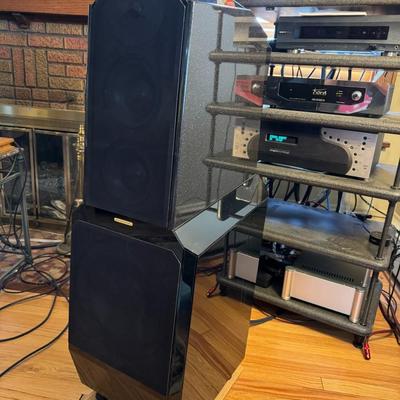
EgglestonWorks Andra Center Speaker Single owner and proffesionally cared for. Near to new as you can get. Colour : The black Dimensions, mm : 393 x 457 x 380 Weight, kg : 24.8 Main characteristics Sensitivity, : dB 87 Resistance, : Ohm 8 Frequency range, : Hz - kHz 78 - 24 Colour : The black Dimensions, mm : 393 x 457 x 380 Weight, kg : 24.8 It's always tough to follow an award-winning act. Wes Phillips raved about the original EgglestonWorks Andra back in October 1997, and it was subsequently dubbed Stereophile's Speaker of the Year for 1997. The Andra won many other plaudits, and found its way into a number of top-shelf recording studios as the monitor of choice. Such a reputation for excellence is the stuff most speaker designers dream of. It also imposes the burden of expectation—the "new and improved" version of such a knockout product had better be good, or else. Since the Andra's debut in Stereophile there have been big changes at EgglestonWorks. While too complex to detail here, the end result is that the company is now under the resolute leadership of president Michael Sabre and director of sales and marketing Jim Thompson, but remains in its tradition-rich home of Memphis, Tennessee. When Sabre and Thompson determined that the time was ripe for updating the Andra, they didn't have far to look for inspiration. After Sabre assumed control of the company, EW developed their titanic Ivy Reference in collaboration with mastering legend Bob Ludwig, for use as Ludwig's reference at Gateway Mastering. The Ivy was then translated into the only slightly less imposing Savoy. The lofty ambitions of the Andra II project were to make significant and meaningful improvements to the Andra, ladling in a large share of the performance of the $100,000/pair Ivy and $40,000/pair Savoy. The primary goals were more accurate amplitude response, higher efficiency, deeper bass response, and a major increase in overall transparency—a tall order. Evolution at Work Some of what has changed in the journey from Andra to Andra II is apparent at first glance. The Andra II is more than 7" taller than the original. The cabinet has very thick (1.53-1.79") walls of layers of MDF laminated together with vibration-damping adhesives, then cut to shape on a computer-controlled milling machine. The slim top section, containing the midrange drivers and tweeter, remains clad in black granite, and the overall fit and finish are everything one would expect in a speaker costing nearly $20,000/pair. With their slender top sections and deep-cabinet design, the Andras do not overpower a room, and their handsome presence attracted plenty of appreciative comments. The knuckle-rap test produced only bruised knuckles and a heavily muted tk from the speakers. These are exceedingly dead boxes. A glance around the back of the speaker shows another major change. The cabinet is now a sealed box, and the woofer chamber is 50% larger than that of the original Andra. Just about all that hasn't changed are the drivers (footnote 1). The twin Dynaudio 12" woofers have 4" voice-coils to handle high power, and are considerably farther off the floor than in the original Andra. They now operate in a pressure-loaded push/push (isobaric) configuration, and the cabinet in which they work is filled with a non-settling, crimped Dacron called AcoustaStuff. The result is a more even impedance curve and improved efficiency over the first Andra. The Andra's heart remains two beefy 6" Morel 166 midrange drivers connected directly to the speaker's inputs. The Morels are modified by EW to meet their own specifications, have 3" voice-coils, and, like the woofers, can accommodate large amounts of power. The original Andra ran these drivers full-range, but the EW design team became convinced that driver-to-driver differences in the Morels' top-end rolloff compromised the speaker's ultimate performance. One of the most challenging exercises for the EW team was therefore developing a crossover network that let the Morels work only in their most effective bandwidth without affecting the speaker's much-lauded midrange. According to Sabre, achieving this took months of work, primarily listening. The midrange drivers now operate with sealed transmission-line loading, with more AcoustaStuff packed into the labyrinth. Up top, the Dynaudio Esotar tweeter still holds pride of place. If there's a better dome tweeter, I haven't heard it. 3 / 167 -
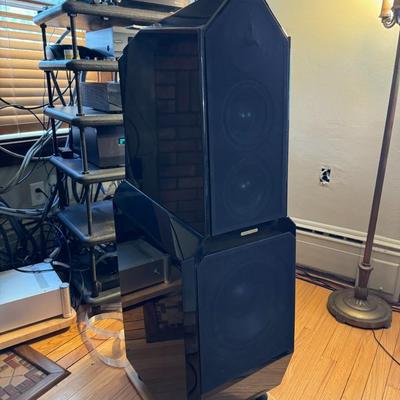
EgglestonWorks Andra Center Speaker Single owner and proffesionally cared for. Near to new as you can get. Colour : The black Dimensions, mm : 393 x 457 x 380 Weight, kg : 24.8 Main characteristics Sensitivity, : dB 87 Resistance, : Ohm 8 Frequency range, : Hz - kHz 78 - 24 Colour : The black Dimensions, mm : 393 x 457 x 380 Weight, kg : 24.8 It's always tough to follow an award-winning act. Wes Phillips raved about the original EgglestonWorks Andra back in October 1997, and it was subsequently dubbed Stereophile's Speaker of the Year for 1997. The Andra won many other plaudits, and found its way into a number of top-shelf recording studios as the monitor of choice. Such a reputation for excellence is the stuff most speaker designers dream of. It also imposes the burden of expectation—the "new and improved" version of such a knockout product had better be good, or else. Since the Andra's debut in Stereophile there have been big changes at EgglestonWorks. While too complex to detail here, the end result is that the company is now under the resolute leadership of president Michael Sabre and director of sales and marketing Jim Thompson, but remains in its tradition-rich home of Memphis, Tennessee. When Sabre and Thompson determined that the time was ripe for updating the Andra, they didn't have far to look for inspiration. After Sabre assumed control of the company, EW developed their titanic Ivy Reference in collaboration with mastering legend Bob Ludwig, for use as Ludwig's reference at Gateway Mastering. The Ivy was then translated into the only slightly less imposing Savoy. The lofty ambitions of the Andra II project were to make significant and meaningful improvements to the Andra, ladling in a large share of the performance of the $100,000/pair Ivy and $40,000/pair Savoy. The primary goals were more accurate amplitude response, higher efficiency, deeper bass response, and a major increase in overall transparency—a tall order. Evolution at Work Some of what has changed in the journey from Andra to Andra II is apparent at first glance. The Andra II is more than 7" taller than the original. The cabinet has very thick (1.53-1.79") walls of layers of MDF laminated together with vibration-damping adhesives, then cut to shape on a computer-controlled milling machine. The slim top section, containing the midrange drivers and tweeter, remains clad in black granite, and the overall fit and finish are everything one would expect in a speaker costing nearly $20,000/pair. With their slender top sections and deep-cabinet design, the Andras do not overpower a room, and their handsome presence attracted plenty of appreciative comments. The knuckle-rap test produced only bruised knuckles and a heavily muted tk from the speakers. These are exceedingly dead boxes. A glance around the back of the speaker shows another major change. The cabinet is now a sealed box, and the woofer chamber is 50% larger than that of the original Andra. Just about all that hasn't changed are the drivers (footnote 1). The twin Dynaudio 12" woofers have 4" voice-coils to handle high power, and are considerably farther off the floor than in the original Andra. They now operate in a pressure-loaded push/push (isobaric) configuration, and the cabinet in which they work is filled with a non-settling, crimped Dacron called AcoustaStuff. The result is a more even impedance curve and improved efficiency over the first Andra. The Andra's heart remains two beefy 6" Morel 166 midrange drivers connected directly to the speaker's inputs. The Morels are modified by EW to meet their own specifications, have 3" voice-coils, and, like the woofers, can accommodate large amounts of power. The original Andra ran these drivers full-range, but the EW design team became convinced that driver-to-driver differences in the Morels' top-end rolloff compromised the speaker's ultimate performance. One of the most challenging exercises for the EW team was therefore developing a crossover network that let the Morels work only in their most effective bandwidth without affecting the speaker's much-lauded midrange. According to Sabre, achieving this took months of work, primarily listening. The midrange drivers now operate with sealed transmission-line loading, with more AcoustaStuff packed into the labyrinth. Up top, the Dynaudio Esotar tweeter still holds pride of place. If there's a better dome tweeter, I haven't heard it. 4 / 167 -

EgglestonWorks Andra Center Speaker Single owner and proffesionally cared for. Near to new as you can get. Colour : The black Dimensions, mm : 393 x 457 x 380 Weight, kg : 24.8 Main characteristics Sensitivity, : dB 87 Resistance, : Ohm 8 Frequency range, : Hz - kHz 78 - 24 Colour : The black Dimensions, mm : 393 x 457 x 380 Weight, kg : 24.8 It's always tough to follow an award-winning act. Wes Phillips raved about the original EgglestonWorks Andra back in October 1997, and it was subsequently dubbed Stereophile's Speaker of the Year for 1997. The Andra won many other plaudits, and found its way into a number of top-shelf recording studios as the monitor of choice. Such a reputation for excellence is the stuff most speaker designers dream of. It also imposes the burden of expectation—the "new and improved" version of such a knockout product had better be good, or else. Since the Andra's debut in Stereophile there have been big changes at EgglestonWorks. While too complex to detail here, the end result is that the company is now under the resolute leadership of president Michael Sabre and director of sales and marketing Jim Thompson, but remains in its tradition-rich home of Memphis, Tennessee. When Sabre and Thompson determined that the time was ripe for updating the Andra, they didn't have far to look for inspiration. After Sabre assumed control of the company, EW developed their titanic Ivy Reference in collaboration with mastering legend Bob Ludwig, for use as Ludwig's reference at Gateway Mastering. The Ivy was then translated into the only slightly less imposing Savoy. The lofty ambitions of the Andra II project were to make significant and meaningful improvements to the Andra, ladling in a large share of the performance of the $100,000/pair Ivy and $40,000/pair Savoy. The primary goals were more accurate amplitude response, higher efficiency, deeper bass response, and a major increase in overall transparency—a tall order. Evolution at Work Some of what has changed in the journey from Andra to Andra II is apparent at first glance. The Andra II is more than 7" taller than the original. The cabinet has very thick (1.53-1.79") walls of layers of MDF laminated together with vibration-damping adhesives, then cut to shape on a computer-controlled milling machine. The slim top section, containing the midrange drivers and tweeter, remains clad in black granite, and the overall fit and finish are everything one would expect in a speaker costing nearly $20,000/pair. With their slender top sections and deep-cabinet design, the Andras do not overpower a room, and their handsome presence attracted plenty of appreciative comments. The knuckle-rap test produced only bruised knuckles and a heavily muted tk from the speakers. These are exceedingly dead boxes. A glance around the back of the speaker shows another major change. The cabinet is now a sealed box, and the woofer chamber is 50% larger than that of the original Andra. Just about all that hasn't changed are the drivers (footnote 1). The twin Dynaudio 12" woofers have 4" voice-coils to handle high power, and are considerably farther off the floor than in the original Andra. They now operate in a pressure-loaded push/push (isobaric) configuration, and the cabinet in which they work is filled with a non-settling, crimped Dacron called AcoustaStuff. The result is a more even impedance curve and improved efficiency over the first Andra. The Andra's heart remains two beefy 6" Morel 166 midrange drivers connected directly to the speaker's inputs. The Morels are modified by EW to meet their own specifications, have 3" voice-coils, and, like the woofers, can accommodate large amounts of power. The original Andra ran these drivers full-range, but the EW design team became convinced that driver-to-driver differences in the Morels' top-end rolloff compromised the speaker's ultimate performance. One of the most challenging exercises for the EW team was therefore developing a crossover network that let the Morels work only in their most effective bandwidth without affecting the speaker's much-lauded midrange. According to Sabre, achieving this took months of work, primarily listening. The midrange drivers now operate with sealed transmission-line loading, with more AcoustaStuff packed into the labyrinth. Up top, the Dynaudio Esotar tweeter still holds pride of place. If there's a better dome tweeter, I haven't heard it. 5 / 167 -
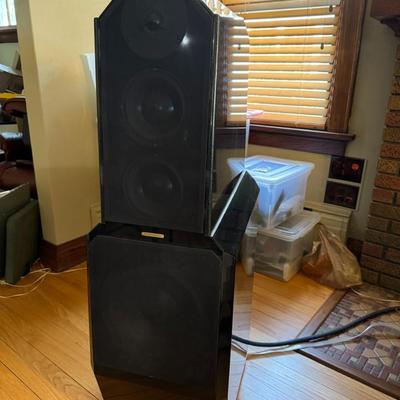
EgglestonWorks Andra Center Speaker Single owner and proffesionally cared for. Near to new as you can get. Colour : The black Dimensions, mm : 393 x 457 x 380 Weight, kg : 24.8 Main characteristics Sensitivity, : dB 87 Resistance, : Ohm 8 Frequency range, : Hz - kHz 78 - 24 Colour : The black Dimensions, mm : 393 x 457 x 380 Weight, kg : 24.8 It's always tough to follow an award-winning act. Wes Phillips raved about the original EgglestonWorks Andra back in October 1997, and it was subsequently dubbed Stereophile's Speaker of the Year for 1997. The Andra won many other plaudits, and found its way into a number of top-shelf recording studios as the monitor of choice. Such a reputation for excellence is the stuff most speaker designers dream of. It also imposes the burden of expectation—the "new and improved" version of such a knockout product had better be good, or else. Since the Andra's debut in Stereophile there have been big changes at EgglestonWorks. While too complex to detail here, the end result is that the company is now under the resolute leadership of president Michael Sabre and director of sales and marketing Jim Thompson, but remains in its tradition-rich home of Memphis, Tennessee. When Sabre and Thompson determined that the time was ripe for updating the Andra, they didn't have far to look for inspiration. After Sabre assumed control of the company, EW developed their titanic Ivy Reference in collaboration with mastering legend Bob Ludwig, for use as Ludwig's reference at Gateway Mastering. The Ivy was then translated into the only slightly less imposing Savoy. The lofty ambitions of the Andra II project were to make significant and meaningful improvements to the Andra, ladling in a large share of the performance of the $100,000/pair Ivy and $40,000/pair Savoy. The primary goals were more accurate amplitude response, higher efficiency, deeper bass response, and a major increase in overall transparency—a tall order. Evolution at Work Some of what has changed in the journey from Andra to Andra II is apparent at first glance. The Andra II is more than 7" taller than the original. The cabinet has very thick (1.53-1.79") walls of layers of MDF laminated together with vibration-damping adhesives, then cut to shape on a computer-controlled milling machine. The slim top section, containing the midrange drivers and tweeter, remains clad in black granite, and the overall fit and finish are everything one would expect in a speaker costing nearly $20,000/pair. With their slender top sections and deep-cabinet design, the Andras do not overpower a room, and their handsome presence attracted plenty of appreciative comments. The knuckle-rap test produced only bruised knuckles and a heavily muted tk from the speakers. These are exceedingly dead boxes. A glance around the back of the speaker shows another major change. The cabinet is now a sealed box, and the woofer chamber is 50% larger than that of the original Andra. Just about all that hasn't changed are the drivers (footnote 1). The twin Dynaudio 12" woofers have 4" voice-coils to handle high power, and are considerably farther off the floor than in the original Andra. They now operate in a pressure-loaded push/push (isobaric) configuration, and the cabinet in which they work is filled with a non-settling, crimped Dacron called AcoustaStuff. The result is a more even impedance curve and improved efficiency over the first Andra. The Andra's heart remains two beefy 6" Morel 166 midrange drivers connected directly to the speaker's inputs. The Morels are modified by EW to meet their own specifications, have 3" voice-coils, and, like the woofers, can accommodate large amounts of power. The original Andra ran these drivers full-range, but the EW design team became convinced that driver-to-driver differences in the Morels' top-end rolloff compromised the speaker's ultimate performance. One of the most challenging exercises for the EW team was therefore developing a crossover network that let the Morels work only in their most effective bandwidth without affecting the speaker's much-lauded midrange. According to Sabre, achieving this took months of work, primarily listening. The midrange drivers now operate with sealed transmission-line loading, with more AcoustaStuff packed into the labyrinth. Up top, the Dynaudio Esotar tweeter still holds pride of place. If there's a better dome tweeter, I haven't heard it. 6 / 167 -
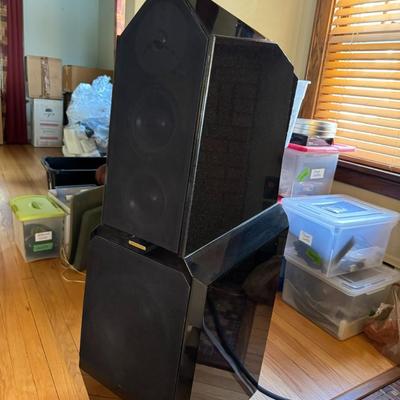
EgglestonWorks Andra Center Speaker Single owner and proffesionally cared for. Near to new as you can get. Colour : The black Dimensions, mm : 393 x 457 x 380 Weight, kg : 24.8 Main characteristics Sensitivity, : dB 87 Resistance, : Ohm 8 Frequency range, : Hz - kHz 78 - 24 Colour : The black Dimensions, mm : 393 x 457 x 380 Weight, kg : 24.8 It's always tough to follow an award-winning act. Wes Phillips raved about the original EgglestonWorks Andra back in October 1997, and it was subsequently dubbed Stereophile's Speaker of the Year for 1997. The Andra won many other plaudits, and found its way into a number of top-shelf recording studios as the monitor of choice. Such a reputation for excellence is the stuff most speaker designers dream of. It also imposes the burden of expectation—the "new and improved" version of such a knockout product had better be good, or else. Since the Andra's debut in Stereophile there have been big changes at EgglestonWorks. While too complex to detail here, the end result is that the company is now under the resolute leadership of president Michael Sabre and director of sales and marketing Jim Thompson, but remains in its tradition-rich home of Memphis, Tennessee. When Sabre and Thompson determined that the time was ripe for updating the Andra, they didn't have far to look for inspiration. After Sabre assumed control of the company, EW developed their titanic Ivy Reference in collaboration with mastering legend Bob Ludwig, for use as Ludwig's reference at Gateway Mastering. The Ivy was then translated into the only slightly less imposing Savoy. The lofty ambitions of the Andra II project were to make significant and meaningful improvements to the Andra, ladling in a large share of the performance of the $100,000/pair Ivy and $40,000/pair Savoy. The primary goals were more accurate amplitude response, higher efficiency, deeper bass response, and a major increase in overall transparency—a tall order. Evolution at Work Some of what has changed in the journey from Andra to Andra II is apparent at first glance. The Andra II is more than 7" taller than the original. The cabinet has very thick (1.53-1.79") walls of layers of MDF laminated together with vibration-damping adhesives, then cut to shape on a computer-controlled milling machine. The slim top section, containing the midrange drivers and tweeter, remains clad in black granite, and the overall fit and finish are everything one would expect in a speaker costing nearly $20,000/pair. With their slender top sections and deep-cabinet design, the Andras do not overpower a room, and their handsome presence attracted plenty of appreciative comments. The knuckle-rap test produced only bruised knuckles and a heavily muted tk from the speakers. These are exceedingly dead boxes. A glance around the back of the speaker shows another major change. The cabinet is now a sealed box, and the woofer chamber is 50% larger than that of the original Andra. Just about all that hasn't changed are the drivers (footnote 1). The twin Dynaudio 12" woofers have 4" voice-coils to handle high power, and are considerably farther off the floor than in the original Andra. They now operate in a pressure-loaded push/push (isobaric) configuration, and the cabinet in which they work is filled with a non-settling, crimped Dacron called AcoustaStuff. The result is a more even impedance curve and improved efficiency over the first Andra. The Andra's heart remains two beefy 6" Morel 166 midrange drivers connected directly to the speaker's inputs. The Morels are modified by EW to meet their own specifications, have 3" voice-coils, and, like the woofers, can accommodate large amounts of power. The original Andra ran these drivers full-range, but the EW design team became convinced that driver-to-driver differences in the Morels' top-end rolloff compromised the speaker's ultimate performance. One of the most challenging exercises for the EW team was therefore developing a crossover network that let the Morels work only in their most effective bandwidth without affecting the speaker's much-lauded midrange. According to Sabre, achieving this took months of work, primarily listening. The midrange drivers now operate with sealed transmission-line loading, with more AcoustaStuff packed into the labyrinth. Up top, the Dynaudio Esotar tweeter still holds pride of place. If there's a better dome tweeter, I haven't heard it. 7 / 167 -
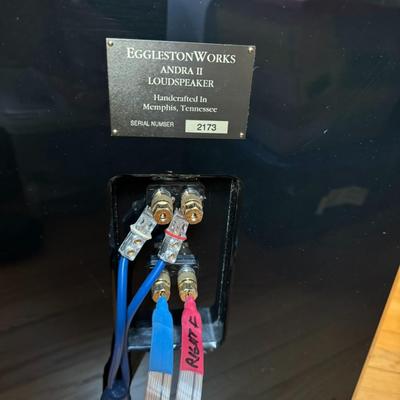
EgglestonWorks Andra Center Speaker Single owner and proffesionally cared for. Near to new as you can get. Colour : The black Dimensions, mm : 393 x 457 x 380 Weight, kg : 24.8 Main characteristics Sensitivity, : dB 87 Resistance, : Ohm 8 Frequency range, : Hz - kHz 78 - 24 Colour : The black Dimensions, mm : 393 x 457 x 380 Weight, kg : 24.8 It's always tough to follow an award-winning act. Wes Phillips raved about the original EgglestonWorks Andra back in October 1997, and it was subsequently dubbed Stereophile's Speaker of the Year for 1997. The Andra won many other plaudits, and found its way into a number of top-shelf recording studios as the monitor of choice. Such a reputation for excellence is the stuff most speaker designers dream of. It also imposes the burden of expectation—the "new and improved" version of such a knockout product had better be good, or else. Since the Andra's debut in Stereophile there have been big changes at EgglestonWorks. While too complex to detail here, the end result is that the company is now under the resolute leadership of president Michael Sabre and director of sales and marketing Jim Thompson, but remains in its tradition-rich home of Memphis, Tennessee. When Sabre and Thompson determined that the time was ripe for updating the Andra, they didn't have far to look for inspiration. After Sabre assumed control of the company, EW developed their titanic Ivy Reference in collaboration with mastering legend Bob Ludwig, for use as Ludwig's reference at Gateway Mastering. The Ivy was then translated into the only slightly less imposing Savoy. The lofty ambitions of the Andra II project were to make significant and meaningful improvements to the Andra, ladling in a large share of the performance of the $100,000/pair Ivy and $40,000/pair Savoy. The primary goals were more accurate amplitude response, higher efficiency, deeper bass response, and a major increase in overall transparency—a tall order. Evolution at Work Some of what has changed in the journey from Andra to Andra II is apparent at first glance. The Andra II is more than 7" taller than the original. The cabinet has very thick (1.53-1.79") walls of layers of MDF laminated together with vibration-damping adhesives, then cut to shape on a computer-controlled milling machine. The slim top section, containing the midrange drivers and tweeter, remains clad in black granite, and the overall fit and finish are everything one would expect in a speaker costing nearly $20,000/pair. With their slender top sections and deep-cabinet design, the Andras do not overpower a room, and their handsome presence attracted plenty of appreciative comments. The knuckle-rap test produced only bruised knuckles and a heavily muted tk from the speakers. These are exceedingly dead boxes. A glance around the back of the speaker shows another major change. The cabinet is now a sealed box, and the woofer chamber is 50% larger than that of the original Andra. Just about all that hasn't changed are the drivers (footnote 1). The twin Dynaudio 12" woofers have 4" voice-coils to handle high power, and are considerably farther off the floor than in the original Andra. They now operate in a pressure-loaded push/push (isobaric) configuration, and the cabinet in which they work is filled with a non-settling, crimped Dacron called AcoustaStuff. The result is a more even impedance curve and improved efficiency over the first Andra. The Andra's heart remains two beefy 6" Morel 166 midrange drivers connected directly to the speaker's inputs. The Morels are modified by EW to meet their own specifications, have 3" voice-coils, and, like the woofers, can accommodate large amounts of power. The original Andra ran these drivers full-range, but the EW design team became convinced that driver-to-driver differences in the Morels' top-end rolloff compromised the speaker's ultimate performance. One of the most challenging exercises for the EW team was therefore developing a crossover network that let the Morels work only in their most effective bandwidth without affecting the speaker's much-lauded midrange. According to Sabre, achieving this took months of work, primarily listening. The midrange drivers now operate with sealed transmission-line loading, with more AcoustaStuff packed into the labyrinth. Up top, the Dynaudio Esotar tweeter still holds pride of place. If there's a better dome tweeter, I haven't heard it. 8 / 167 -
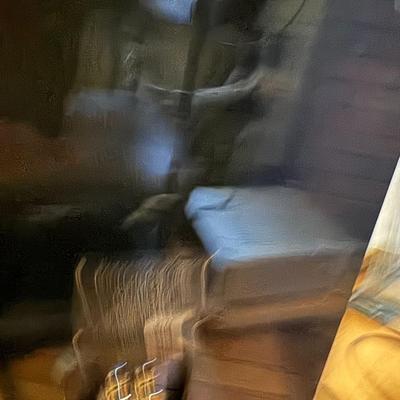
EgglestonWorks Andra Center Speaker Single owner and proffesionally cared for. Near to new as you can get. Colour : The black Dimensions, mm : 393 x 457 x 380 Weight, kg : 24.8 Main characteristics Sensitivity, : dB 87 Resistance, : Ohm 8 Frequency range, : Hz - kHz 78 - 24 Colour : The black Dimensions, mm : 393 x 457 x 380 Weight, kg : 24.8 It's always tough to follow an award-winning act. Wes Phillips raved about the original EgglestonWorks Andra back in October 1997, and it was subsequently dubbed Stereophile's Speaker of the Year for 1997. The Andra won many other plaudits, and found its way into a number of top-shelf recording studios as the monitor of choice. Such a reputation for excellence is the stuff most speaker designers dream of. It also imposes the burden of expectation—the "new and improved" version of such a knockout product had better be good, or else. Since the Andra's debut in Stereophile there have been big changes at EgglestonWorks. While too complex to detail here, the end result is that the company is now under the resolute leadership of president Michael Sabre and director of sales and marketing Jim Thompson, but remains in its tradition-rich home of Memphis, Tennessee. When Sabre and Thompson determined that the time was ripe for updating the Andra, they didn't have far to look for inspiration. After Sabre assumed control of the company, EW developed their titanic Ivy Reference in collaboration with mastering legend Bob Ludwig, for use as Ludwig's reference at Gateway Mastering. The Ivy was then translated into the only slightly less imposing Savoy. The lofty ambitions of the Andra II project were to make significant and meaningful improvements to the Andra, ladling in a large share of the performance of the $100,000/pair Ivy and $40,000/pair Savoy. The primary goals were more accurate amplitude response, higher efficiency, deeper bass response, and a major increase in overall transparency—a tall order. Evolution at Work Some of what has changed in the journey from Andra to Andra II is apparent at first glance. The Andra II is more than 7" taller than the original. The cabinet has very thick (1.53-1.79") walls of layers of MDF laminated together with vibration-damping adhesives, then cut to shape on a computer-controlled milling machine. The slim top section, containing the midrange drivers and tweeter, remains clad in black granite, and the overall fit and finish are everything one would expect in a speaker costing nearly $20,000/pair. With their slender top sections and deep-cabinet design, the Andras do not overpower a room, and their handsome presence attracted plenty of appreciative comments. The knuckle-rap test produced only bruised knuckles and a heavily muted tk from the speakers. These are exceedingly dead boxes. A glance around the back of the speaker shows another major change. The cabinet is now a sealed box, and the woofer chamber is 50% larger than that of the original Andra. Just about all that hasn't changed are the drivers (footnote 1). The twin Dynaudio 12" woofers have 4" voice-coils to handle high power, and are considerably farther off the floor than in the original Andra. They now operate in a pressure-loaded push/push (isobaric) configuration, and the cabinet in which they work is filled with a non-settling, crimped Dacron called AcoustaStuff. The result is a more even impedance curve and improved efficiency over the first Andra. The Andra's heart remains two beefy 6" Morel 166 midrange drivers connected directly to the speaker's inputs. The Morels are modified by EW to meet their own specifications, have 3" voice-coils, and, like the woofers, can accommodate large amounts of power. The original Andra ran these drivers full-range, but the EW design team became convinced that driver-to-driver differences in the Morels' top-end rolloff compromised the speaker's ultimate performance. One of the most challenging exercises for the EW team was therefore developing a crossover network that let the Morels work only in their most effective bandwidth without affecting the speaker's much-lauded midrange. According to Sabre, achieving this took months of work, primarily listening. The midrange drivers now operate with sealed transmission-line loading, with more AcoustaStuff packed into the labyrinth. Up top, the Dynaudio Esotar tweeter still holds pride of place. If there's a better dome tweeter, I haven't heard it. 9 / 167 -

EgglestonWorks Andra Center Speaker Single owner and proffesionally cared for. Near to new as you can get. Colour : The black Dimensions, mm : 393 x 457 x 380 Weight, kg : 24.8 Main characteristics Sensitivity, : dB 87 Resistance, : Ohm 8 Frequency range, : Hz - kHz 78 - 24 Colour : The black Dimensions, mm : 393 x 457 x 380 Weight, kg : 24.8 It's always tough to follow an award-winning act. Wes Phillips raved about the original EgglestonWorks Andra back in October 1997, and it was subsequently dubbed Stereophile's Speaker of the Year for 1997. The Andra won many other plaudits, and found its way into a number of top-shelf recording studios as the monitor of choice. Such a reputation for excellence is the stuff most speaker designers dream of. It also imposes the burden of expectation—the "new and improved" version of such a knockout product had better be good, or else. Since the Andra's debut in Stereophile there have been big changes at EgglestonWorks. While too complex to detail here, the end result is that the company is now under the resolute leadership of president Michael Sabre and director of sales and marketing Jim Thompson, but remains in its tradition-rich home of Memphis, Tennessee. When Sabre and Thompson determined that the time was ripe for updating the Andra, they didn't have far to look for inspiration. After Sabre assumed control of the company, EW developed their titanic Ivy Reference in collaboration with mastering legend Bob Ludwig, for use as Ludwig's reference at Gateway Mastering. The Ivy was then translated into the only slightly less imposing Savoy. The lofty ambitions of the Andra II project were to make significant and meaningful improvements to the Andra, ladling in a large share of the performance of the $100,000/pair Ivy and $40,000/pair Savoy. The primary goals were more accurate amplitude response, higher efficiency, deeper bass response, and a major increase in overall transparency—a tall order. Evolution at Work Some of what has changed in the journey from Andra to Andra II is apparent at first glance. The Andra II is more than 7" taller than the original. The cabinet has very thick (1.53-1.79") walls of layers of MDF laminated together with vibration-damping adhesives, then cut to shape on a computer-controlled milling machine. The slim top section, containing the midrange drivers and tweeter, remains clad in black granite, and the overall fit and finish are everything one would expect in a speaker costing nearly $20,000/pair. With their slender top sections and deep-cabinet design, the Andras do not overpower a room, and their handsome presence attracted plenty of appreciative comments. The knuckle-rap test produced only bruised knuckles and a heavily muted tk from the speakers. These are exceedingly dead boxes. A glance around the back of the speaker shows another major change. The cabinet is now a sealed box, and the woofer chamber is 50% larger than that of the original Andra. Just about all that hasn't changed are the drivers (footnote 1). The twin Dynaudio 12" woofers have 4" voice-coils to handle high power, and are considerably farther off the floor than in the original Andra. They now operate in a pressure-loaded push/push (isobaric) configuration, and the cabinet in which they work is filled with a non-settling, crimped Dacron called AcoustaStuff. The result is a more even impedance curve and improved efficiency over the first Andra. The Andra's heart remains two beefy 6" Morel 166 midrange drivers connected directly to the speaker's inputs. The Morels are modified by EW to meet their own specifications, have 3" voice-coils, and, like the woofers, can accommodate large amounts of power. The original Andra ran these drivers full-range, but the EW design team became convinced that driver-to-driver differences in the Morels' top-end rolloff compromised the speaker's ultimate performance. One of the most challenging exercises for the EW team was therefore developing a crossover network that let the Morels work only in their most effective bandwidth without affecting the speaker's much-lauded midrange. According to Sabre, achieving this took months of work, primarily listening. The midrange drivers now operate with sealed transmission-line loading, with more AcoustaStuff packed into the labyrinth. Up top, the Dynaudio Esotar tweeter still holds pride of place. If there's a better dome tweeter, I haven't heard it. 10 / 167 -
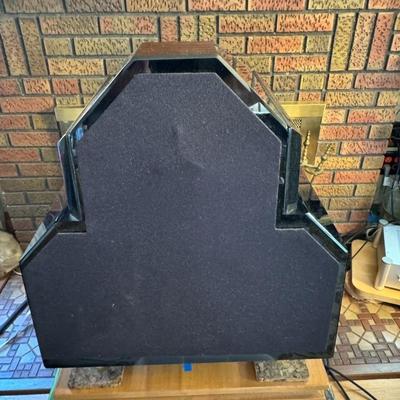
EgglestonWorks Andra Center Speaker Single owner and proffesionally cared for. Near to new as you can get. Colour : The black Dimensions, mm : 393 x 457 x 380 Weight, kg : 24.8 Main characteristics Sensitivity, : dB 87 Resistance, : Ohm 8 Frequency range, : Hz - kHz 78 - 24 Colour : The black Dimensions, mm : 393 x 457 x 380 Weight, kg : 24.8 It's always tough to follow an award-winning act. Wes Phillips raved about the original EgglestonWorks Andra back in October 1997, and it was subsequently dubbed Stereophile's Speaker of the Year for 1997. The Andra won many other plaudits, and found its way into a number of top-shelf recording studios as the monitor of choice. Such a reputation for excellence is the stuff most speaker designers dream of. It also imposes the burden of expectation—the "new and improved" version of such a knockout product had better be good, or else. Since the Andra's debut in Stereophile there have been big changes at EgglestonWorks. While too complex to detail here, the end result is that the company is now under the resolute leadership of president Michael Sabre and director of sales and marketing Jim Thompson, but remains in its tradition-rich home of Memphis, Tennessee. When Sabre and Thompson determined that the time was ripe for updating the Andra, they didn't have far to look for inspiration. After Sabre assumed control of the company, EW developed their titanic Ivy Reference in collaboration with mastering legend Bob Ludwig, for use as Ludwig's reference at Gateway Mastering. The Ivy was then translated into the only slightly less imposing Savoy. The lofty ambitions of the Andra II project were to make significant and meaningful improvements to the Andra, ladling in a large share of the performance of the $100,000/pair Ivy and $40,000/pair Savoy. The primary goals were more accurate amplitude response, higher efficiency, deeper bass response, and a major increase in overall transparency—a tall order. Evolution at Work Some of what has changed in the journey from Andra to Andra II is apparent at first glance. The Andra II is more than 7" taller than the original. The cabinet has very thick (1.53-1.79") walls of layers of MDF laminated together with vibration-damping adhesives, then cut to shape on a computer-controlled milling machine. The slim top section, containing the midrange drivers and tweeter, remains clad in black granite, and the overall fit and finish are everything one would expect in a speaker costing nearly $20,000/pair. With their slender top sections and deep-cabinet design, the Andras do not overpower a room, and their handsome presence attracted plenty of appreciative comments. The knuckle-rap test produced only bruised knuckles and a heavily muted tk from the speakers. These are exceedingly dead boxes. A glance around the back of the speaker shows another major change. The cabinet is now a sealed box, and the woofer chamber is 50% larger than that of the original Andra. Just about all that hasn't changed are the drivers (footnote 1). The twin Dynaudio 12" woofers have 4" voice-coils to handle high power, and are considerably farther off the floor than in the original Andra. They now operate in a pressure-loaded push/push (isobaric) configuration, and the cabinet in which they work is filled with a non-settling, crimped Dacron called AcoustaStuff. The result is a more even impedance curve and improved efficiency over the first Andra. The Andra's heart remains two beefy 6" Morel 166 midrange drivers connected directly to the speaker's inputs. The Morels are modified by EW to meet their own specifications, have 3" voice-coils, and, like the woofers, can accommodate large amounts of power. The original Andra ran these drivers full-range, but the EW design team became convinced that driver-to-driver differences in the Morels' top-end rolloff compromised the speaker's ultimate performance. One of the most challenging exercises for the EW team was therefore developing a crossover network that let the Morels work only in their most effective bandwidth without affecting the speaker's much-lauded midrange. According to Sabre, achieving this took months of work, primarily listening. The midrange drivers now operate with sealed transmission-line loading, with more AcoustaStuff packed into the labyrinth. Up top, the Dynaudio Esotar tweeter still holds pride of place. If there's a better dome tweeter, I haven't heard it. 11 / 167 -
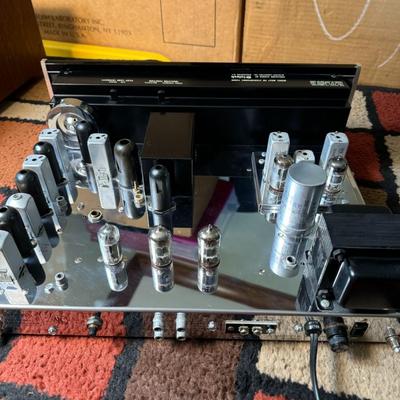
For your consideration, A beautiful McIntosh MR67 Tuner. Minty condition and operating as a solid unit. Owned and maintained by a seasoned Audiophile. Front Panel: Anodized gold and black aluminum panel. Illuminated tuning dial. Electron ray tube: multi path and signal strength. Stereo MPX indicator. Illuminated tuning meter. Tuning control. Volume control. Mode selector switch: MPX stereo or FM mono. Power switch: on or off. Muting switch: on or off. Panloc buttons. Early units had electron ray tuning (green) and multipath and signal strength (blue) on the left with mpx stereo (red) light on the right. Back Panel: Muting adjustment. Left and right audio outputs: 2.5V fixed output and 2.5V front panel controlled. Screw terminals for 300 or 75 ohm FM antenna. Power cord. Fuse. Unswitched AC outlet. Panloc mounting. Top Panel: Pilot lamp intensity: bright or dim. Indicator function: signal strength or multipath. FM Section: RF Sensitivity 2.5uV. AF Response 20Hz to 20kHz � 0.5dB. Distortion < 0.5%. Capture 1.7dB. Image rejection > 60dB. Four IF stages. Two limiters. Separation 30dB. Tubes: 6DS4, 12AT7, 6AB4, (3) 6AU6, 6CS6, 6AV6, EMM801, (2) 6BL8, 6U8, 12AU7 Production: 6,507 units made from April 1963 to November 1968. SN 100T1 to 608T7 12 / 167 -
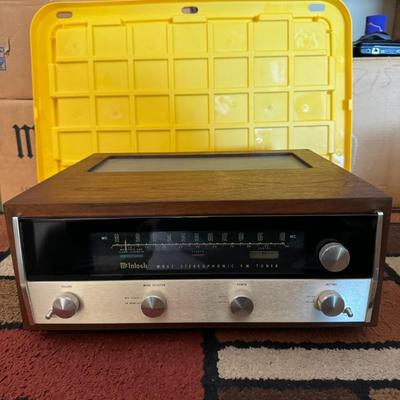
For your consideration, A beautiful McIntosh MR67 Tuner. Minty condition and operating as a solid unit. Owned and maintained by a seasoned Audiophile. Front Panel: Anodized gold and black aluminum panel. Illuminated tuning dial. Electron ray tube: multi path and signal strength. Stereo MPX indicator. Illuminated tuning meter. Tuning control. Volume control. Mode selector switch: MPX stereo or FM mono. Power switch: on or off. Muting switch: on or off. Panloc buttons. Early units had electron ray tuning (green) and multipath and signal strength (blue) on the left with mpx stereo (red) light on the right. Back Panel: Muting adjustment. Left and right audio outputs: 2.5V fixed output and 2.5V front panel controlled. Screw terminals for 300 or 75 ohm FM antenna. Power cord. Fuse. Unswitched AC outlet. Panloc mounting. Top Panel: Pilot lamp intensity: bright or dim. Indicator function: signal strength or multipath. FM Section: RF Sensitivity 2.5uV. AF Response 20Hz to 20kHz � 0.5dB. Distortion < 0.5%. Capture 1.7dB. Image rejection > 60dB. Four IF stages. Two limiters. Separation 30dB. Tubes: 6DS4, 12AT7, 6AB4, (3) 6AU6, 6CS6, 6AV6, EMM801, (2) 6BL8, 6U8, 12AU7 Production: 6,507 units made from April 1963 to November 1968. SN 100T1 to 608T7 13 / 167 -
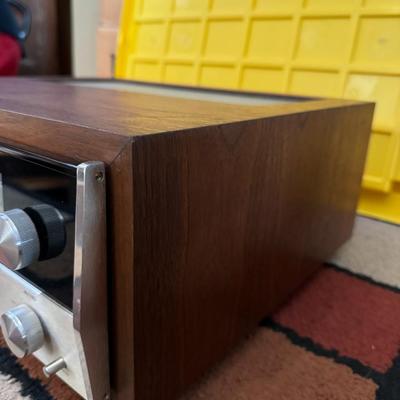
For your consideration, A beautiful McIntosh MR67 Tuner. Minty condition and operating as a solid unit. Owned and maintained by a seasoned Audiophile. Front Panel: Anodized gold and black aluminum panel. Illuminated tuning dial. Electron ray tube: multi path and signal strength. Stereo MPX indicator. Illuminated tuning meter. Tuning control. Volume control. Mode selector switch: MPX stereo or FM mono. Power switch: on or off. Muting switch: on or off. Panloc buttons. Early units had electron ray tuning (green) and multipath and signal strength (blue) on the left with mpx stereo (red) light on the right. Back Panel: Muting adjustment. Left and right audio outputs: 2.5V fixed output and 2.5V front panel controlled. Screw terminals for 300 or 75 ohm FM antenna. Power cord. Fuse. Unswitched AC outlet. Panloc mounting. Top Panel: Pilot lamp intensity: bright or dim. Indicator function: signal strength or multipath. FM Section: RF Sensitivity 2.5uV. AF Response 20Hz to 20kHz � 0.5dB. Distortion < 0.5%. Capture 1.7dB. Image rejection > 60dB. Four IF stages. Two limiters. Separation 30dB. Tubes: 6DS4, 12AT7, 6AB4, (3) 6AU6, 6CS6, 6AV6, EMM801, (2) 6BL8, 6U8, 12AU7 Production: 6,507 units made from April 1963 to November 1968. SN 100T1 to 608T7 14 / 167 -
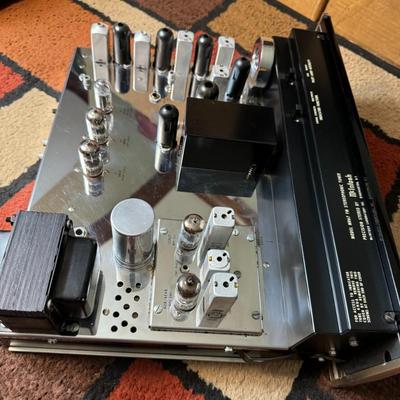
For your consideration, A beautiful McIntosh MR67 Tuner. Minty condition and operating as a solid unit. Owned and maintained by a seasoned Audiophile. Front Panel: Anodized gold and black aluminum panel. Illuminated tuning dial. Electron ray tube: multi path and signal strength. Stereo MPX indicator. Illuminated tuning meter. Tuning control. Volume control. Mode selector switch: MPX stereo or FM mono. Power switch: on or off. Muting switch: on or off. Panloc buttons. Early units had electron ray tuning (green) and multipath and signal strength (blue) on the left with mpx stereo (red) light on the right. Back Panel: Muting adjustment. Left and right audio outputs: 2.5V fixed output and 2.5V front panel controlled. Screw terminals for 300 or 75 ohm FM antenna. Power cord. Fuse. Unswitched AC outlet. Panloc mounting. Top Panel: Pilot lamp intensity: bright or dim. Indicator function: signal strength or multipath. FM Section: RF Sensitivity 2.5uV. AF Response 20Hz to 20kHz � 0.5dB. Distortion < 0.5%. Capture 1.7dB. Image rejection > 60dB. Four IF stages. Two limiters. Separation 30dB. Tubes: 6DS4, 12AT7, 6AB4, (3) 6AU6, 6CS6, 6AV6, EMM801, (2) 6BL8, 6U8, 12AU7 Production: 6,507 units made from April 1963 to November 1968. SN 100T1 to 608T7 15 / 167 -
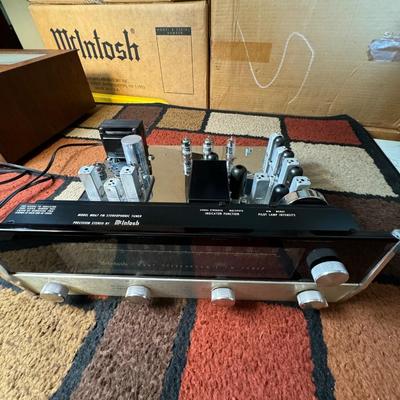
For your consideration, A beautiful McIntosh MR67 Tuner. Minty condition and operating as a solid unit. Owned and maintained by a seasoned Audiophile. Front Panel: Anodized gold and black aluminum panel. Illuminated tuning dial. Electron ray tube: multi path and signal strength. Stereo MPX indicator. Illuminated tuning meter. Tuning control. Volume control. Mode selector switch: MPX stereo or FM mono. Power switch: on or off. Muting switch: on or off. Panloc buttons. Early units had electron ray tuning (green) and multipath and signal strength (blue) on the left with mpx stereo (red) light on the right. Back Panel: Muting adjustment. Left and right audio outputs: 2.5V fixed output and 2.5V front panel controlled. Screw terminals for 300 or 75 ohm FM antenna. Power cord. Fuse. Unswitched AC outlet. Panloc mounting. Top Panel: Pilot lamp intensity: bright or dim. Indicator function: signal strength or multipath. FM Section: RF Sensitivity 2.5uV. AF Response 20Hz to 20kHz � 0.5dB. Distortion < 0.5%. Capture 1.7dB. Image rejection > 60dB. Four IF stages. Two limiters. Separation 30dB. Tubes: 6DS4, 12AT7, 6AB4, (3) 6AU6, 6CS6, 6AV6, EMM801, (2) 6BL8, 6U8, 12AU7 Production: 6,507 units made from April 1963 to November 1968. SN 100T1 to 608T7 16 / 167 -
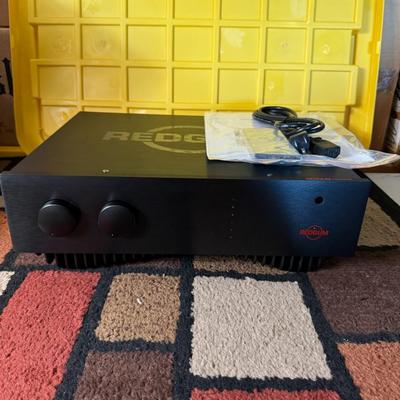
A “New” Generation of Integrated amplifiers – the Black Signature Series! But how new is “New”!? Add in “purpose-designed to power ultra-low speaker impedances”, while keeping it all in the family with the same circuit boards and Dual Mono remote control as Amplifolia range products. This electronically-cloned Black Series RGi35ENR was named in deference to its wood-panelled clone “mother”, the then 50Wpc original REDGUM Signature Series RGi35ENR (now renamed for the Amplifolia Range as the Stellulata). BUT now purpose-designed as the Black Series to drive ultra-low speaker impedances, the mother’s official rating gives only a hint of the full powers realised here by her offspring … 65Wpc into 8Ω Transient 140W Short term RMS 80Wpc into 4Ω Transient 280W Short term RMS 95Wpc into 2Ω Transient 560W Short term RMS Being a turbo-charged version of the long tried-and-trusted original REDGUM RGi35ENR, the Black Series RGi35ENR remains totally a REDGUM design. As for any chip off the old block, naturally it has the same REDGUM sound! N.B. All REDGUM amplifiers have inputs suitable for Home Theatre Bypass. H 150 x 410 W x 370 D mm / H 6 x 16 W x 14.5 D in 16.5 kg / 36.4 lb 17 / 167 -
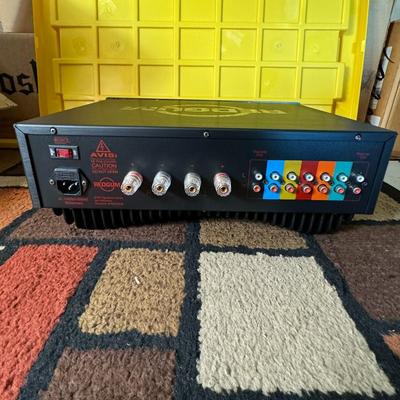
A “New” Generation of Integrated amplifiers – the Black Signature Series! But how new is “New”!? Add in “purpose-designed to power ultra-low speaker impedances”, while keeping it all in the family with the same circuit boards and Dual Mono remote control as Amplifolia range products. This electronically-cloned Black Series RGi35ENR was named in deference to its wood-panelled clone “mother”, the then 50Wpc original REDGUM Signature Series RGi35ENR (now renamed for the Amplifolia Range as the Stellulata). BUT now purpose-designed as the Black Series to drive ultra-low speaker impedances, the mother’s official rating gives only a hint of the full powers realised here by her offspring … 65Wpc into 8Ω Transient 140W Short term RMS 80Wpc into 4Ω Transient 280W Short term RMS 95Wpc into 2Ω Transient 560W Short term RMS Being a turbo-charged version of the long tried-and-trusted original REDGUM RGi35ENR, the Black Series RGi35ENR remains totally a REDGUM design. As for any chip off the old block, naturally it has the same REDGUM sound! N.B. All REDGUM amplifiers have inputs suitable for Home Theatre Bypass. H 150 x 410 W x 370 D mm / H 6 x 16 W x 14.5 D in 16.5 kg / 36.4 lb 18 / 167 -
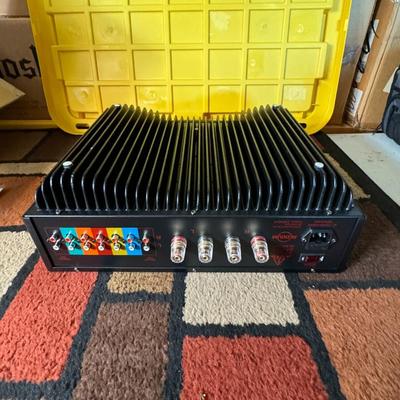
A “New” Generation of Integrated amplifiers – the Black Signature Series! But how new is “New”!? Add in “purpose-designed to power ultra-low speaker impedances”, while keeping it all in the family with the same circuit boards and Dual Mono remote control as Amplifolia range products. This electronically-cloned Black Series RGi35ENR was named in deference to its wood-panelled clone “mother”, the then 50Wpc original REDGUM Signature Series RGi35ENR (now renamed for the Amplifolia Range as the Stellulata). BUT now purpose-designed as the Black Series to drive ultra-low speaker impedances, the mother’s official rating gives only a hint of the full powers realised here by her offspring … 65Wpc into 8Ω Transient 140W Short term RMS 80Wpc into 4Ω Transient 280W Short term RMS 95Wpc into 2Ω Transient 560W Short term RMS Being a turbo-charged version of the long tried-and-trusted original REDGUM RGi35ENR, the Black Series RGi35ENR remains totally a REDGUM design. As for any chip off the old block, naturally it has the same REDGUM sound! N.B. All REDGUM amplifiers have inputs suitable for Home Theatre Bypass. H 150 x 410 W x 370 D mm / H 6 x 16 W x 14.5 D in 16.5 kg / 36.4 lb 19 / 167 -
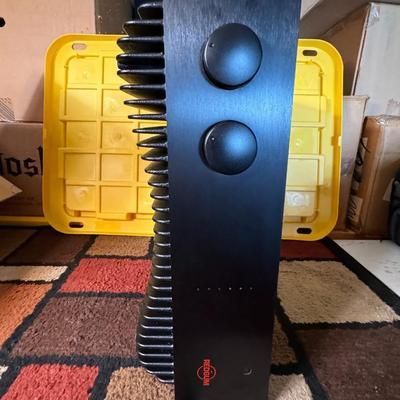
A “New” Generation of Integrated amplifiers – the Black Signature Series! But how new is “New”!? Add in “purpose-designed to power ultra-low speaker impedances”, while keeping it all in the family with the same circuit boards and Dual Mono remote control as Amplifolia range products. This electronically-cloned Black Series RGi35ENR was named in deference to its wood-panelled clone “mother”, the then 50Wpc original REDGUM Signature Series RGi35ENR (now renamed for the Amplifolia Range as the Stellulata). BUT now purpose-designed as the Black Series to drive ultra-low speaker impedances, the mother’s official rating gives only a hint of the full powers realised here by her offspring … 65Wpc into 8Ω Transient 140W Short term RMS 80Wpc into 4Ω Transient 280W Short term RMS 95Wpc into 2Ω Transient 560W Short term RMS Being a turbo-charged version of the long tried-and-trusted original REDGUM RGi35ENR, the Black Series RGi35ENR remains totally a REDGUM design. As for any chip off the old block, naturally it has the same REDGUM sound! N.B. All REDGUM amplifiers have inputs suitable for Home Theatre Bypass. H 150 x 410 W x 370 D mm / H 6 x 16 W x 14.5 D in 16.5 kg / 36.4 lb 20 / 167 -

A “New” Generation of Integrated amplifiers – the Black Signature Series! But how new is “New”!? Add in “purpose-designed to power ultra-low speaker impedances”, while keeping it all in the family with the same circuit boards and Dual Mono remote control as Amplifolia range products. This electronically-cloned Black Series RGi35ENR was named in deference to its wood-panelled clone “mother”, the then 50Wpc original REDGUM Signature Series RGi35ENR (now renamed for the Amplifolia Range as the Stellulata). BUT now purpose-designed as the Black Series to drive ultra-low speaker impedances, the mother’s official rating gives only a hint of the full powers realised here by her offspring … 65Wpc into 8Ω Transient 140W Short term RMS 80Wpc into 4Ω Transient 280W Short term RMS 95Wpc into 2Ω Transient 560W Short term RMS Being a turbo-charged version of the long tried-and-trusted original REDGUM RGi35ENR, the Black Series RGi35ENR remains totally a REDGUM design. As for any chip off the old block, naturally it has the same REDGUM sound! N.B. All REDGUM amplifiers have inputs suitable for Home Theatre Bypass. H 150 x 410 W x 370 D mm / H 6 x 16 W x 14.5 D in 16.5 kg / 36.4 lb 21 / 167 -
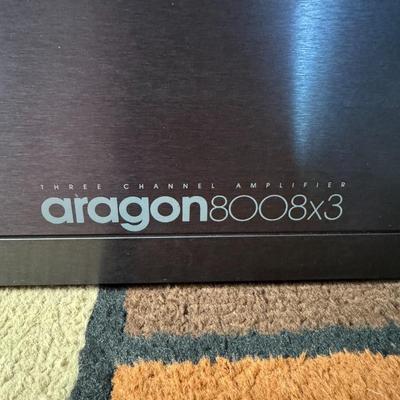
Owned since new by a mindful adult audiophile. In like new condition. 8008x3 Three Channel Power Amplifier Rated Power: 200 watts/channel @8 ohms, all channels driven, 400 watts/channel @4 ohms, all channels driven. FR: 5 Hz - 20 kHz (Flat) THD: < 0.05% Size: 8"H x 19"W x 15 1/2"D Weight: 68 Pounds MSRP: $2,499 USA ( in 1999 ) 22 / 167 -

Owned since new by a mindful adult audiophile. In like new condition. 8008x3 Three Channel Power Amplifier Rated Power: 200 watts/channel @8 ohms, all channels driven, 400 watts/channel @4 ohms, all channels driven. FR: 5 Hz - 20 kHz (Flat) THD: < 0.05% Size: 8"H x 19"W x 15 1/2"D Weight: 68 Pounds MSRP: $2,499 USA ( in 1999 ) 23 / 167 -
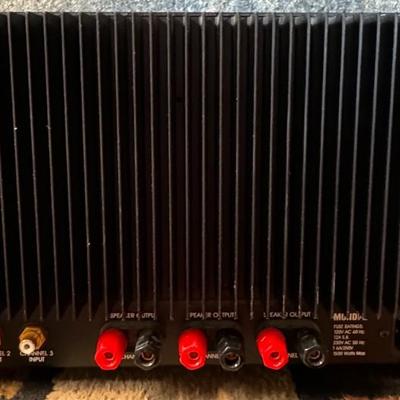
Owned since new by a mindful adult audiophile. In like new condition. 8008x3 Three Channel Power Amplifier Rated Power: 200 watts/channel @8 ohms, all channels driven, 400 watts/channel @4 ohms, all channels driven. FR: 5 Hz - 20 kHz (Flat) THD: < 0.05% Size: 8"H x 19"W x 15 1/2"D Weight: 68 Pounds MSRP: $2,499 USA ( in 1999 ) 24 / 167 -
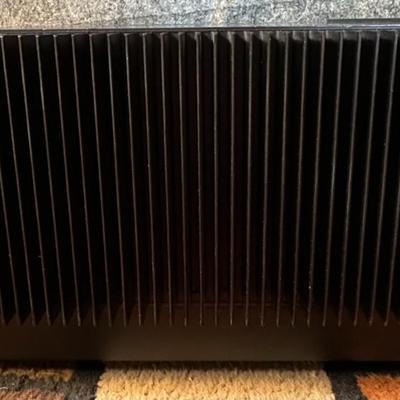
Owned since new by a mindful adult audiophile. In like new condition. 8008x3 Three Channel Power Amplifier Rated Power: 200 watts/channel @8 ohms, all channels driven, 400 watts/channel @4 ohms, all channels driven. FR: 5 Hz - 20 kHz (Flat) THD: < 0.05% Size: 8"H x 19"W x 15 1/2"D Weight: 68 Pounds MSRP: $2,499 USA ( in 1999 ) 25 / 167 -
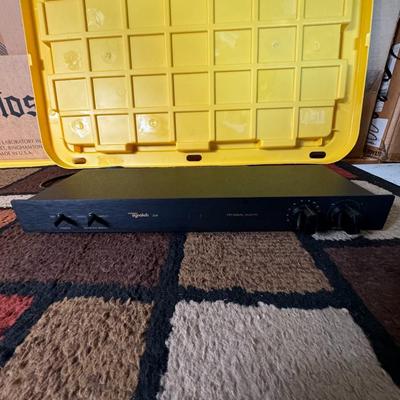
The Signal Sleuth FM Signal Amplifier uncovers the full potential of FM signals. Bring fringe stations to full health and enjoy mediocre stations to the max with the Magnum/Dynalab Signal Sleuth! 3 Stage FM tuner amplifier Unique in the world because it only amplifies the station you are tuned to up to 30 db. You can also decrease the signal by up to 30 db. If you are experiencing overload from a close station. Steeply rejects by 18 db. Per octave all other stations By-pass mode Tuning knob tunes to the station you wish to amplify The gain knob allows you to boost the signal or decrease it. Detachable power cord. 26 / 167 sold -
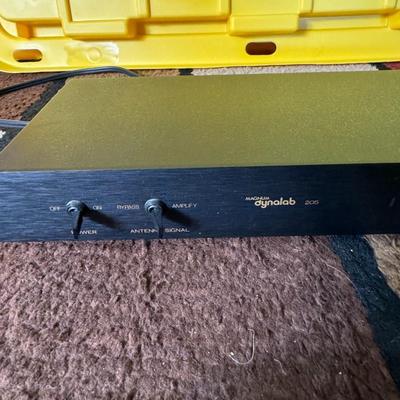
The Signal Sleuth FM Signal Amplifier uncovers the full potential of FM signals. Bring fringe stations to full health and enjoy mediocre stations to the max with the Magnum/Dynalab Signal Sleuth! 3 Stage FM tuner amplifier Unique in the world because it only amplifies the station you are tuned to up to 30 db. You can also decrease the signal by up to 30 db. If you are experiencing overload from a close station. Steeply rejects by 18 db. Per octave all other stations By-pass mode Tuning knob tunes to the station you wish to amplify The gain knob allows you to boost the signal or decrease it. Detachable power cord. 27 / 167 sold -

The Signal Sleuth FM Signal Amplifier uncovers the full potential of FM signals. Bring fringe stations to full health and enjoy mediocre stations to the max with the Magnum/Dynalab Signal Sleuth! 3 Stage FM tuner amplifier Unique in the world because it only amplifies the station you are tuned to up to 30 db. You can also decrease the signal by up to 30 db. If you are experiencing overload from a close station. Steeply rejects by 18 db. Per octave all other stations By-pass mode Tuning knob tunes to the station you wish to amplify The gain knob allows you to boost the signal or decrease it. Detachable power cord. 28 / 167 sold -
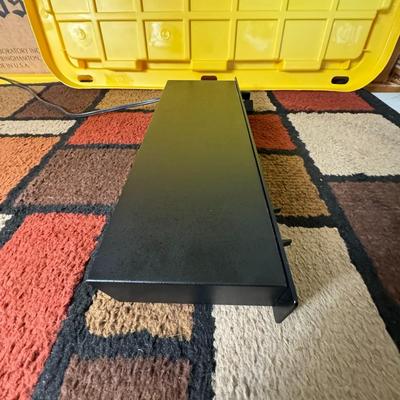
The Signal Sleuth FM Signal Amplifier uncovers the full potential of FM signals. Bring fringe stations to full health and enjoy mediocre stations to the max with the Magnum/Dynalab Signal Sleuth! 3 Stage FM tuner amplifier Unique in the world because it only amplifies the station you are tuned to up to 30 db. You can also decrease the signal by up to 30 db. If you are experiencing overload from a close station. Steeply rejects by 18 db. Per octave all other stations By-pass mode Tuning knob tunes to the station you wish to amplify The gain knob allows you to boost the signal or decrease it. Detachable power cord. 29 / 167 sold -
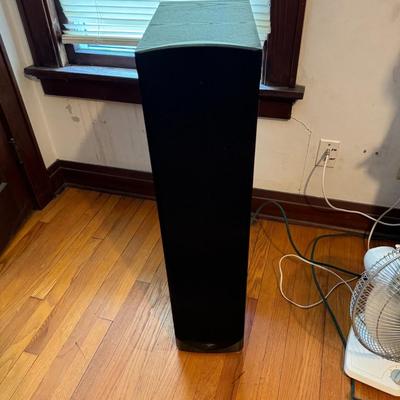
Where the Paradigms did not fail was in their ability to throw as big a soundstage as the Revels, and in the inaudibility of their crossover transitions. Taken by themselves, the Paradigms did an impressive and musically satisfying job. If I couldn't afford better and more costly speakers, I could live happily ever after with the 60 v.3s as the speakers in my two-channel listening system. I then trucked the Paradigms up to Connecticut, to audition them in a different acoustic and to hear how they worked as part of a multichannel setup. Much as I like to describe a component's inherent characteristics before making comparisons, the Studio/60 v.3s were replacing their immediate forebears, the v.2s, and comparisons were unavoidable. At first, the v.3 seemed to have a bit less bass extension than the v.2, though it had substantially greater fullness and weight in the bass above 80Hz. The v.3 was slightly more forward in the midrange, but also much clearer and more detailed. In the extreme high frequencies, brushed cymbals sounded comparable on both versions of the Studio/60, but small movements of my head influenced my perceptions, so I can't be adamant about that. Overall, the v.3s produced a slightly wider, deeper soundstage, and remained more engaging over long listening sessions. However, in the midst of evaluating the Studio/60 v.3, the acoustics of my multichannel listening room were drastically improved by the installation of a number of Real Traps (footnote 1), which changed everything. While the v.2 also sounded better in this new acoustic environment, the distinctions between v.2 and v.3 became much more distinct. With wideband white noise and a little head movement, I could hear the crossover from the v.2's tweeter to the other drivers from as far away as 6'. With the v.3, however, the white noise seemed to come from a single source, as long as my ears were at least 1-2' from the speaker. In this setup, at my normal listening distance of about 9', I heard subtle suggestions of the same difference with music. The v.3 was, as it had been in my two-channel system, integrated and seamless, with no excess sibilance, and normal sibilants were not disconnected from the main voice. Esquina de SP (SACD, Saidera SD-1027H) is a live recording of Brazilian singer Wilma de Oliveira, accompanied by guitar, drums, and a small vocal group. The two-channel tracks are spacious, with an intoxicating club atmosphere that the multichannel track enhances only slightly. (This SACD is strange; the multichannel tracks and the two-channel DSD and "Red Book" tracks have 11 songs in common, as well as several not found on the other tracks.) De Oliveira's warm, lilting voice was front and center, but I could easily hear her respond to each of the other performers without ever going off-mike. Overall, I enjoyed a delightful evening of classic samba and bossa nova, Studio/60 v.3s revealing the harmonies and the percussive spice; the v.2s were caught out by several effects that excessively highlighted the cymbals. The acoustic improvements wrought by the Real Traps also revealed my misjudgment of the Studio/60 v.3's bass performance. Apparently, the speaker's upper-bass output had been exciting room modes that now were damped by the Real Traps. As a result, the v.3 now went as deep as the v.2, and more smoothly—even though, on paper, the v.2 has a bit greater extension. Listening to Buster Williams' piccolo bass variations on a theme from Rodrigo's Concierto de Aranjuez, on Griot Liberte (CD, High Note HCD7123), I was impressed with the tightness and power across the instrument's range. Admittedly, this was no bass stress test in the audiophile sense, but as one follows Buster's explication of Rodrigo in detail, it is a musical stress test of the speaker and room. Rudy Van Gelder's production and the Studio/60 v.3s delivered, whether in two or five channels, with no help needed from a subwoofer. Indeed, switching in my Paradigm Servo-15 subwoofer below 40Hz via an Outlaw ICBM bass manager was counterproductive—it emphasized room sound more than the instrument. The Studio/60 v.3s handled the really big stuff, such as the Berlioz Requiem with Robert Spano and the Atlanta Symphony Orchestra and Chorus (SACD, Telarc SACD-80627), with power and aplomb, whether in two channels or many. Their multichannel performance was particularly extraordinary: I ran the Studio/60 v.3s full-range as the main left and right speakers, aided by a Studio/60 v.2 in the center and a pair of Studio/20 v.2s in the rear. The purity of the voices was never corrupted by the need to simultaneously invest huge acoustical power in reproducing the orchestra and brass bands. When I added Paradigm's Servo-15, it mostly just gilded the lily—the Studio/60 v.3s didn't need much help to sound absolutely spectacular. Conclusions I originally bought my Paradigm Studio/60 v.2s because I wanted small floorstanding speakers that had full-range sound, and they filled the bill. The Studio/60 v.3 is significantly bigger and significantly better than the v.2. Perhaps the most important improvement is in the v.3's overall smoothness and balance, from the low bass all the way to the top. This is difficult to achieve, and has been the downfall of many speakers, especially low- to mid-priced floorstanders. It's also why many listeners forgo deep bass altogether in this price range, preferring to go with small two-way monitor speakers. The Paradigm Reference Studio/60 v.3, however, has a seamlessness and a wide frequency range that I usually associate with speakers many times its price. Over the years, I've reviewed a number of speakers in the $1000-$2000/pair range because this is where, it seems to me, the going gets tough. Speakers costing less than $1000/pair usually include serious compromises, and those costing more than $2000/pair, no matter how good they are, can be enjoyed only by the relative few who can afford them. In this range, several other speakers have outstanding and desirable traits, but no speaker costing anywhere near $1600/pair has a better integration of all performance parameters than Paradigm's Reference Studio/60 v.3. 30 / 167 -
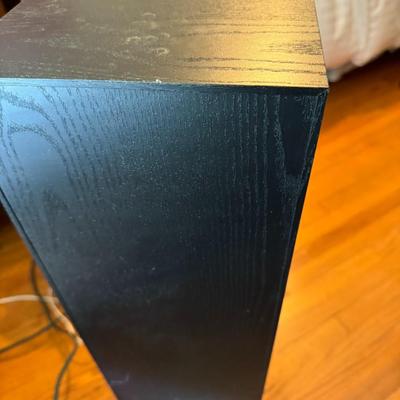
Where the Paradigms did not fail was in their ability to throw as big a soundstage as the Revels, and in the inaudibility of their crossover transitions. Taken by themselves, the Paradigms did an impressive and musically satisfying job. If I couldn't afford better and more costly speakers, I could live happily ever after with the 60 v.3s as the speakers in my two-channel listening system. I then trucked the Paradigms up to Connecticut, to audition them in a different acoustic and to hear how they worked as part of a multichannel setup. Much as I like to describe a component's inherent characteristics before making comparisons, the Studio/60 v.3s were replacing their immediate forebears, the v.2s, and comparisons were unavoidable. At first, the v.3 seemed to have a bit less bass extension than the v.2, though it had substantially greater fullness and weight in the bass above 80Hz. The v.3 was slightly more forward in the midrange, but also much clearer and more detailed. In the extreme high frequencies, brushed cymbals sounded comparable on both versions of the Studio/60, but small movements of my head influenced my perceptions, so I can't be adamant about that. Overall, the v.3s produced a slightly wider, deeper soundstage, and remained more engaging over long listening sessions. However, in the midst of evaluating the Studio/60 v.3, the acoustics of my multichannel listening room were drastically improved by the installation of a number of Real Traps (footnote 1), which changed everything. While the v.2 also sounded better in this new acoustic environment, the distinctions between v.2 and v.3 became much more distinct. With wideband white noise and a little head movement, I could hear the crossover from the v.2's tweeter to the other drivers from as far away as 6'. With the v.3, however, the white noise seemed to come from a single source, as long as my ears were at least 1-2' from the speaker. In this setup, at my normal listening distance of about 9', I heard subtle suggestions of the same difference with music. The v.3 was, as it had been in my two-channel system, integrated and seamless, with no excess sibilance, and normal sibilants were not disconnected from the main voice. Esquina de SP (SACD, Saidera SD-1027H) is a live recording of Brazilian singer Wilma de Oliveira, accompanied by guitar, drums, and a small vocal group. The two-channel tracks are spacious, with an intoxicating club atmosphere that the multichannel track enhances only slightly. (This SACD is strange; the multichannel tracks and the two-channel DSD and "Red Book" tracks have 11 songs in common, as well as several not found on the other tracks.) De Oliveira's warm, lilting voice was front and center, but I could easily hear her respond to each of the other performers without ever going off-mike. Overall, I enjoyed a delightful evening of classic samba and bossa nova, Studio/60 v.3s revealing the harmonies and the percussive spice; the v.2s were caught out by several effects that excessively highlighted the cymbals. The acoustic improvements wrought by the Real Traps also revealed my misjudgment of the Studio/60 v.3's bass performance. Apparently, the speaker's upper-bass output had been exciting room modes that now were damped by the Real Traps. As a result, the v.3 now went as deep as the v.2, and more smoothly—even though, on paper, the v.2 has a bit greater extension. Listening to Buster Williams' piccolo bass variations on a theme from Rodrigo's Concierto de Aranjuez, on Griot Liberte (CD, High Note HCD7123), I was impressed with the tightness and power across the instrument's range. Admittedly, this was no bass stress test in the audiophile sense, but as one follows Buster's explication of Rodrigo in detail, it is a musical stress test of the speaker and room. Rudy Van Gelder's production and the Studio/60 v.3s delivered, whether in two or five channels, with no help needed from a subwoofer. Indeed, switching in my Paradigm Servo-15 subwoofer below 40Hz via an Outlaw ICBM bass manager was counterproductive—it emphasized room sound more than the instrument. The Studio/60 v.3s handled the really big stuff, such as the Berlioz Requiem with Robert Spano and the Atlanta Symphony Orchestra and Chorus (SACD, Telarc SACD-80627), with power and aplomb, whether in two channels or many. Their multichannel performance was particularly extraordinary: I ran the Studio/60 v.3s full-range as the main left and right speakers, aided by a Studio/60 v.2 in the center and a pair of Studio/20 v.2s in the rear. The purity of the voices was never corrupted by the need to simultaneously invest huge acoustical power in reproducing the orchestra and brass bands. When I added Paradigm's Servo-15, it mostly just gilded the lily—the Studio/60 v.3s didn't need much help to sound absolutely spectacular. Conclusions I originally bought my Paradigm Studio/60 v.2s because I wanted small floorstanding speakers that had full-range sound, and they filled the bill. The Studio/60 v.3 is significantly bigger and significantly better than the v.2. Perhaps the most important improvement is in the v.3's overall smoothness and balance, from the low bass all the way to the top. This is difficult to achieve, and has been the downfall of many speakers, especially low- to mid-priced floorstanders. It's also why many listeners forgo deep bass altogether in this price range, preferring to go with small two-way monitor speakers. The Paradigm Reference Studio/60 v.3, however, has a seamlessness and a wide frequency range that I usually associate with speakers many times its price. Over the years, I've reviewed a number of speakers in the $1000-$2000/pair range because this is where, it seems to me, the going gets tough. Speakers costing less than $1000/pair usually include serious compromises, and those costing more than $2000/pair, no matter how good they are, can be enjoyed only by the relative few who can afford them. In this range, several other speakers have outstanding and desirable traits, but no speaker costing anywhere near $1600/pair has a better integration of all performance parameters than Paradigm's Reference Studio/60 v.3. 31 / 167 -
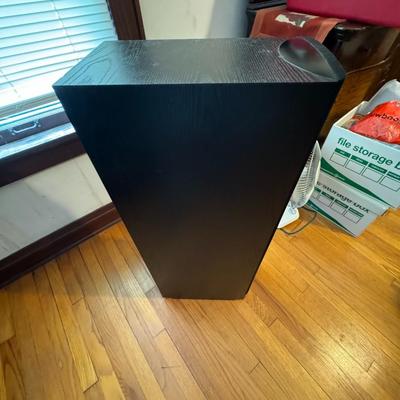
Where the Paradigms did not fail was in their ability to throw as big a soundstage as the Revels, and in the inaudibility of their crossover transitions. Taken by themselves, the Paradigms did an impressive and musically satisfying job. If I couldn't afford better and more costly speakers, I could live happily ever after with the 60 v.3s as the speakers in my two-channel listening system. I then trucked the Paradigms up to Connecticut, to audition them in a different acoustic and to hear how they worked as part of a multichannel setup. Much as I like to describe a component's inherent characteristics before making comparisons, the Studio/60 v.3s were replacing their immediate forebears, the v.2s, and comparisons were unavoidable. At first, the v.3 seemed to have a bit less bass extension than the v.2, though it had substantially greater fullness and weight in the bass above 80Hz. The v.3 was slightly more forward in the midrange, but also much clearer and more detailed. In the extreme high frequencies, brushed cymbals sounded comparable on both versions of the Studio/60, but small movements of my head influenced my perceptions, so I can't be adamant about that. Overall, the v.3s produced a slightly wider, deeper soundstage, and remained more engaging over long listening sessions. However, in the midst of evaluating the Studio/60 v.3, the acoustics of my multichannel listening room were drastically improved by the installation of a number of Real Traps (footnote 1), which changed everything. While the v.2 also sounded better in this new acoustic environment, the distinctions between v.2 and v.3 became much more distinct. With wideband white noise and a little head movement, I could hear the crossover from the v.2's tweeter to the other drivers from as far away as 6'. With the v.3, however, the white noise seemed to come from a single source, as long as my ears were at least 1-2' from the speaker. In this setup, at my normal listening distance of about 9', I heard subtle suggestions of the same difference with music. The v.3 was, as it had been in my two-channel system, integrated and seamless, with no excess sibilance, and normal sibilants were not disconnected from the main voice. Esquina de SP (SACD, Saidera SD-1027H) is a live recording of Brazilian singer Wilma de Oliveira, accompanied by guitar, drums, and a small vocal group. The two-channel tracks are spacious, with an intoxicating club atmosphere that the multichannel track enhances only slightly. (This SACD is strange; the multichannel tracks and the two-channel DSD and "Red Book" tracks have 11 songs in common, as well as several not found on the other tracks.) De Oliveira's warm, lilting voice was front and center, but I could easily hear her respond to each of the other performers without ever going off-mike. Overall, I enjoyed a delightful evening of classic samba and bossa nova, Studio/60 v.3s revealing the harmonies and the percussive spice; the v.2s were caught out by several effects that excessively highlighted the cymbals. The acoustic improvements wrought by the Real Traps also revealed my misjudgment of the Studio/60 v.3's bass performance. Apparently, the speaker's upper-bass output had been exciting room modes that now were damped by the Real Traps. As a result, the v.3 now went as deep as the v.2, and more smoothly—even though, on paper, the v.2 has a bit greater extension. Listening to Buster Williams' piccolo bass variations on a theme from Rodrigo's Concierto de Aranjuez, on Griot Liberte (CD, High Note HCD7123), I was impressed with the tightness and power across the instrument's range. Admittedly, this was no bass stress test in the audiophile sense, but as one follows Buster's explication of Rodrigo in detail, it is a musical stress test of the speaker and room. Rudy Van Gelder's production and the Studio/60 v.3s delivered, whether in two or five channels, with no help needed from a subwoofer. Indeed, switching in my Paradigm Servo-15 subwoofer below 40Hz via an Outlaw ICBM bass manager was counterproductive—it emphasized room sound more than the instrument. The Studio/60 v.3s handled the really big stuff, such as the Berlioz Requiem with Robert Spano and the Atlanta Symphony Orchestra and Chorus (SACD, Telarc SACD-80627), with power and aplomb, whether in two channels or many. Their multichannel performance was particularly extraordinary: I ran the Studio/60 v.3s full-range as the main left and right speakers, aided by a Studio/60 v.2 in the center and a pair of Studio/20 v.2s in the rear. The purity of the voices was never corrupted by the need to simultaneously invest huge acoustical power in reproducing the orchestra and brass bands. When I added Paradigm's Servo-15, it mostly just gilded the lily—the Studio/60 v.3s didn't need much help to sound absolutely spectacular. Conclusions I originally bought my Paradigm Studio/60 v.2s because I wanted small floorstanding speakers that had full-range sound, and they filled the bill. The Studio/60 v.3 is significantly bigger and significantly better than the v.2. Perhaps the most important improvement is in the v.3's overall smoothness and balance, from the low bass all the way to the top. This is difficult to achieve, and has been the downfall of many speakers, especially low- to mid-priced floorstanders. It's also why many listeners forgo deep bass altogether in this price range, preferring to go with small two-way monitor speakers. The Paradigm Reference Studio/60 v.3, however, has a seamlessness and a wide frequency range that I usually associate with speakers many times its price. Over the years, I've reviewed a number of speakers in the $1000-$2000/pair range because this is where, it seems to me, the going gets tough. Speakers costing less than $1000/pair usually include serious compromises, and those costing more than $2000/pair, no matter how good they are, can be enjoyed only by the relative few who can afford them. In this range, several other speakers have outstanding and desirable traits, but no speaker costing anywhere near $1600/pair has a better integration of all performance parameters than Paradigm's Reference Studio/60 v.3. 32 / 167 -
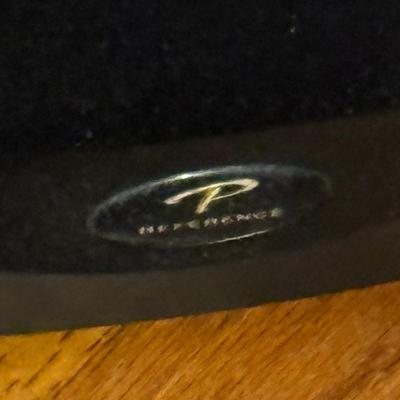
Where the Paradigms did not fail was in their ability to throw as big a soundstage as the Revels, and in the inaudibility of their crossover transitions. Taken by themselves, the Paradigms did an impressive and musically satisfying job. If I couldn't afford better and more costly speakers, I could live happily ever after with the 60 v.3s as the speakers in my two-channel listening system. I then trucked the Paradigms up to Connecticut, to audition them in a different acoustic and to hear how they worked as part of a multichannel setup. Much as I like to describe a component's inherent characteristics before making comparisons, the Studio/60 v.3s were replacing their immediate forebears, the v.2s, and comparisons were unavoidable. At first, the v.3 seemed to have a bit less bass extension than the v.2, though it had substantially greater fullness and weight in the bass above 80Hz. The v.3 was slightly more forward in the midrange, but also much clearer and more detailed. In the extreme high frequencies, brushed cymbals sounded comparable on both versions of the Studio/60, but small movements of my head influenced my perceptions, so I can't be adamant about that. Overall, the v.3s produced a slightly wider, deeper soundstage, and remained more engaging over long listening sessions. However, in the midst of evaluating the Studio/60 v.3, the acoustics of my multichannel listening room were drastically improved by the installation of a number of Real Traps (footnote 1), which changed everything. While the v.2 also sounded better in this new acoustic environment, the distinctions between v.2 and v.3 became much more distinct. With wideband white noise and a little head movement, I could hear the crossover from the v.2's tweeter to the other drivers from as far away as 6'. With the v.3, however, the white noise seemed to come from a single source, as long as my ears were at least 1-2' from the speaker. In this setup, at my normal listening distance of about 9', I heard subtle suggestions of the same difference with music. The v.3 was, as it had been in my two-channel system, integrated and seamless, with no excess sibilance, and normal sibilants were not disconnected from the main voice. Esquina de SP (SACD, Saidera SD-1027H) is a live recording of Brazilian singer Wilma de Oliveira, accompanied by guitar, drums, and a small vocal group. The two-channel tracks are spacious, with an intoxicating club atmosphere that the multichannel track enhances only slightly. (This SACD is strange; the multichannel tracks and the two-channel DSD and "Red Book" tracks have 11 songs in common, as well as several not found on the other tracks.) De Oliveira's warm, lilting voice was front and center, but I could easily hear her respond to each of the other performers without ever going off-mike. Overall, I enjoyed a delightful evening of classic samba and bossa nova, Studio/60 v.3s revealing the harmonies and the percussive spice; the v.2s were caught out by several effects that excessively highlighted the cymbals. The acoustic improvements wrought by the Real Traps also revealed my misjudgment of the Studio/60 v.3's bass performance. Apparently, the speaker's upper-bass output had been exciting room modes that now were damped by the Real Traps. As a result, the v.3 now went as deep as the v.2, and more smoothly—even though, on paper, the v.2 has a bit greater extension. Listening to Buster Williams' piccolo bass variations on a theme from Rodrigo's Concierto de Aranjuez, on Griot Liberte (CD, High Note HCD7123), I was impressed with the tightness and power across the instrument's range. Admittedly, this was no bass stress test in the audiophile sense, but as one follows Buster's explication of Rodrigo in detail, it is a musical stress test of the speaker and room. Rudy Van Gelder's production and the Studio/60 v.3s delivered, whether in two or five channels, with no help needed from a subwoofer. Indeed, switching in my Paradigm Servo-15 subwoofer below 40Hz via an Outlaw ICBM bass manager was counterproductive—it emphasized room sound more than the instrument. The Studio/60 v.3s handled the really big stuff, such as the Berlioz Requiem with Robert Spano and the Atlanta Symphony Orchestra and Chorus (SACD, Telarc SACD-80627), with power and aplomb, whether in two channels or many. Their multichannel performance was particularly extraordinary: I ran the Studio/60 v.3s full-range as the main left and right speakers, aided by a Studio/60 v.2 in the center and a pair of Studio/20 v.2s in the rear. The purity of the voices was never corrupted by the need to simultaneously invest huge acoustical power in reproducing the orchestra and brass bands. When I added Paradigm's Servo-15, it mostly just gilded the lily—the Studio/60 v.3s didn't need much help to sound absolutely spectacular. Conclusions I originally bought my Paradigm Studio/60 v.2s because I wanted small floorstanding speakers that had full-range sound, and they filled the bill. The Studio/60 v.3 is significantly bigger and significantly better than the v.2. Perhaps the most important improvement is in the v.3's overall smoothness and balance, from the low bass all the way to the top. This is difficult to achieve, and has been the downfall of many speakers, especially low- to mid-priced floorstanders. It's also why many listeners forgo deep bass altogether in this price range, preferring to go with small two-way monitor speakers. The Paradigm Reference Studio/60 v.3, however, has a seamlessness and a wide frequency range that I usually associate with speakers many times its price. Over the years, I've reviewed a number of speakers in the $1000-$2000/pair range because this is where, it seems to me, the going gets tough. Speakers costing less than $1000/pair usually include serious compromises, and those costing more than $2000/pair, no matter how good they are, can be enjoyed only by the relative few who can afford them. In this range, several other speakers have outstanding and desirable traits, but no speaker costing anywhere near $1600/pair has a better integration of all performance parameters than Paradigm's Reference Studio/60 v.3. 33 / 167 -

Where the Paradigms did not fail was in their ability to throw as big a soundstage as the Revels, and in the inaudibility of their crossover transitions. Taken by themselves, the Paradigms did an impressive and musically satisfying job. If I couldn't afford better and more costly speakers, I could live happily ever after with the 60 v.3s as the speakers in my two-channel listening system. I then trucked the Paradigms up to Connecticut, to audition them in a different acoustic and to hear how they worked as part of a multichannel setup. Much as I like to describe a component's inherent characteristics before making comparisons, the Studio/60 v.3s were replacing their immediate forebears, the v.2s, and comparisons were unavoidable. At first, the v.3 seemed to have a bit less bass extension than the v.2, though it had substantially greater fullness and weight in the bass above 80Hz. The v.3 was slightly more forward in the midrange, but also much clearer and more detailed. In the extreme high frequencies, brushed cymbals sounded comparable on both versions of the Studio/60, but small movements of my head influenced my perceptions, so I can't be adamant about that. Overall, the v.3s produced a slightly wider, deeper soundstage, and remained more engaging over long listening sessions. However, in the midst of evaluating the Studio/60 v.3, the acoustics of my multichannel listening room were drastically improved by the installation of a number of Real Traps (footnote 1), which changed everything. While the v.2 also sounded better in this new acoustic environment, the distinctions between v.2 and v.3 became much more distinct. With wideband white noise and a little head movement, I could hear the crossover from the v.2's tweeter to the other drivers from as far away as 6'. With the v.3, however, the white noise seemed to come from a single source, as long as my ears were at least 1-2' from the speaker. In this setup, at my normal listening distance of about 9', I heard subtle suggestions of the same difference with music. The v.3 was, as it had been in my two-channel system, integrated and seamless, with no excess sibilance, and normal sibilants were not disconnected from the main voice. Esquina de SP (SACD, Saidera SD-1027H) is a live recording of Brazilian singer Wilma de Oliveira, accompanied by guitar, drums, and a small vocal group. The two-channel tracks are spacious, with an intoxicating club atmosphere that the multichannel track enhances only slightly. (This SACD is strange; the multichannel tracks and the two-channel DSD and "Red Book" tracks have 11 songs in common, as well as several not found on the other tracks.) De Oliveira's warm, lilting voice was front and center, but I could easily hear her respond to each of the other performers without ever going off-mike. Overall, I enjoyed a delightful evening of classic samba and bossa nova, Studio/60 v.3s revealing the harmonies and the percussive spice; the v.2s were caught out by several effects that excessively highlighted the cymbals. The acoustic improvements wrought by the Real Traps also revealed my misjudgment of the Studio/60 v.3's bass performance. Apparently, the speaker's upper-bass output had been exciting room modes that now were damped by the Real Traps. As a result, the v.3 now went as deep as the v.2, and more smoothly—even though, on paper, the v.2 has a bit greater extension. Listening to Buster Williams' piccolo bass variations on a theme from Rodrigo's Concierto de Aranjuez, on Griot Liberte (CD, High Note HCD7123), I was impressed with the tightness and power across the instrument's range. Admittedly, this was no bass stress test in the audiophile sense, but as one follows Buster's explication of Rodrigo in detail, it is a musical stress test of the speaker and room. Rudy Van Gelder's production and the Studio/60 v.3s delivered, whether in two or five channels, with no help needed from a subwoofer. Indeed, switching in my Paradigm Servo-15 subwoofer below 40Hz via an Outlaw ICBM bass manager was counterproductive—it emphasized room sound more than the instrument. The Studio/60 v.3s handled the really big stuff, such as the Berlioz Requiem with Robert Spano and the Atlanta Symphony Orchestra and Chorus (SACD, Telarc SACD-80627), with power and aplomb, whether in two channels or many. Their multichannel performance was particularly extraordinary: I ran the Studio/60 v.3s full-range as the main left and right speakers, aided by a Studio/60 v.2 in the center and a pair of Studio/20 v.2s in the rear. The purity of the voices was never corrupted by the need to simultaneously invest huge acoustical power in reproducing the orchestra and brass bands. When I added Paradigm's Servo-15, it mostly just gilded the lily—the Studio/60 v.3s didn't need much help to sound absolutely spectacular. Conclusions I originally bought my Paradigm Studio/60 v.2s because I wanted small floorstanding speakers that had full-range sound, and they filled the bill. The Studio/60 v.3 is significantly bigger and significantly better than the v.2. Perhaps the most important improvement is in the v.3's overall smoothness and balance, from the low bass all the way to the top. This is difficult to achieve, and has been the downfall of many speakers, especially low- to mid-priced floorstanders. It's also why many listeners forgo deep bass altogether in this price range, preferring to go with small two-way monitor speakers. The Paradigm Reference Studio/60 v.3, however, has a seamlessness and a wide frequency range that I usually associate with speakers many times its price. Over the years, I've reviewed a number of speakers in the $1000-$2000/pair range because this is where, it seems to me, the going gets tough. Speakers costing less than $1000/pair usually include serious compromises, and those costing more than $2000/pair, no matter how good they are, can be enjoyed only by the relative few who can afford them. In this range, several other speakers have outstanding and desirable traits, but no speaker costing anywhere near $1600/pair has a better integration of all performance parameters than Paradigm's Reference Studio/60 v.3. 34 / 167 -
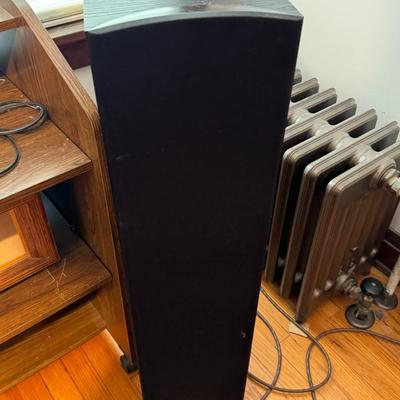
Where the Paradigms did not fail was in their ability to throw as big a soundstage as the Revels, and in the inaudibility of their crossover transitions. Taken by themselves, the Paradigms did an impressive and musically satisfying job. If I couldn't afford better and more costly speakers, I could live happily ever after with the 60 v.3s as the speakers in my two-channel listening system. I then trucked the Paradigms up to Connecticut, to audition them in a different acoustic and to hear how they worked as part of a multichannel setup. Much as I like to describe a component's inherent characteristics before making comparisons, the Studio/60 v.3s were replacing their immediate forebears, the v.2s, and comparisons were unavoidable. At first, the v.3 seemed to have a bit less bass extension than the v.2, though it had substantially greater fullness and weight in the bass above 80Hz. The v.3 was slightly more forward in the midrange, but also much clearer and more detailed. In the extreme high frequencies, brushed cymbals sounded comparable on both versions of the Studio/60, but small movements of my head influenced my perceptions, so I can't be adamant about that. Overall, the v.3s produced a slightly wider, deeper soundstage, and remained more engaging over long listening sessions. However, in the midst of evaluating the Studio/60 v.3, the acoustics of my multichannel listening room were drastically improved by the installation of a number of Real Traps (footnote 1), which changed everything. While the v.2 also sounded better in this new acoustic environment, the distinctions between v.2 and v.3 became much more distinct. With wideband white noise and a little head movement, I could hear the crossover from the v.2's tweeter to the other drivers from as far away as 6'. With the v.3, however, the white noise seemed to come from a single source, as long as my ears were at least 1-2' from the speaker. In this setup, at my normal listening distance of about 9', I heard subtle suggestions of the same difference with music. The v.3 was, as it had been in my two-channel system, integrated and seamless, with no excess sibilance, and normal sibilants were not disconnected from the main voice. Esquina de SP (SACD, Saidera SD-1027H) is a live recording of Brazilian singer Wilma de Oliveira, accompanied by guitar, drums, and a small vocal group. The two-channel tracks are spacious, with an intoxicating club atmosphere that the multichannel track enhances only slightly. (This SACD is strange; the multichannel tracks and the two-channel DSD and "Red Book" tracks have 11 songs in common, as well as several not found on the other tracks.) De Oliveira's warm, lilting voice was front and center, but I could easily hear her respond to each of the other performers without ever going off-mike. Overall, I enjoyed a delightful evening of classic samba and bossa nova, Studio/60 v.3s revealing the harmonies and the percussive spice; the v.2s were caught out by several effects that excessively highlighted the cymbals. The acoustic improvements wrought by the Real Traps also revealed my misjudgment of the Studio/60 v.3's bass performance. Apparently, the speaker's upper-bass output had been exciting room modes that now were damped by the Real Traps. As a result, the v.3 now went as deep as the v.2, and more smoothly—even though, on paper, the v.2 has a bit greater extension. Listening to Buster Williams' piccolo bass variations on a theme from Rodrigo's Concierto de Aranjuez, on Griot Liberte (CD, High Note HCD7123), I was impressed with the tightness and power across the instrument's range. Admittedly, this was no bass stress test in the audiophile sense, but as one follows Buster's explication of Rodrigo in detail, it is a musical stress test of the speaker and room. Rudy Van Gelder's production and the Studio/60 v.3s delivered, whether in two or five channels, with no help needed from a subwoofer. Indeed, switching in my Paradigm Servo-15 subwoofer below 40Hz via an Outlaw ICBM bass manager was counterproductive—it emphasized room sound more than the instrument. The Studio/60 v.3s handled the really big stuff, such as the Berlioz Requiem with Robert Spano and the Atlanta Symphony Orchestra and Chorus (SACD, Telarc SACD-80627), with power and aplomb, whether in two channels or many. Their multichannel performance was particularly extraordinary: I ran the Studio/60 v.3s full-range as the main left and right speakers, aided by a Studio/60 v.2 in the center and a pair of Studio/20 v.2s in the rear. The purity of the voices was never corrupted by the need to simultaneously invest huge acoustical power in reproducing the orchestra and brass bands. When I added Paradigm's Servo-15, it mostly just gilded the lily—the Studio/60 v.3s didn't need much help to sound absolutely spectacular. Conclusions I originally bought my Paradigm Studio/60 v.2s because I wanted small floorstanding speakers that had full-range sound, and they filled the bill. The Studio/60 v.3 is significantly bigger and significantly better than the v.2. Perhaps the most important improvement is in the v.3's overall smoothness and balance, from the low bass all the way to the top. This is difficult to achieve, and has been the downfall of many speakers, especially low- to mid-priced floorstanders. It's also why many listeners forgo deep bass altogether in this price range, preferring to go with small two-way monitor speakers. The Paradigm Reference Studio/60 v.3, however, has a seamlessness and a wide frequency range that I usually associate with speakers many times its price. Over the years, I've reviewed a number of speakers in the $1000-$2000/pair range because this is where, it seems to me, the going gets tough. Speakers costing less than $1000/pair usually include serious compromises, and those costing more than $2000/pair, no matter how good they are, can be enjoyed only by the relative few who can afford them. In this range, several other speakers have outstanding and desirable traits, but no speaker costing anywhere near $1600/pair has a better integration of all performance parameters than Paradigm's Reference Studio/60 v.3. 35 / 167 -
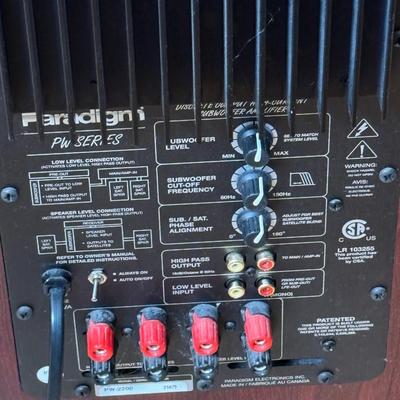
Sound Loud, clean and taut bass -- "can deliver 20Hz bass at levels in excess of 100dB"; external crossover is very transparent. Features Servo-controlled 15" driver; built-in 400W amplifier; external active crossover/controller with phase adjustment; can be purchased with internal crossover too. Use Three high-pass adjustments -- 50Hz, 80Hz and 120Hz -- as well as phase should make it easy to get good results with different speakers in different rooms. Value A lot of technology for $1500; can truly boast significant bang-for-the-buck! There aren’t many components that can access the audio reviewer’s inner-child with greater vigor and rapidity than a big baaaad subwoofer. I am very proud of myself for resisting the urge (most of the time!) to crank the gain of the Servo-15 to unduly exaggerated and punishing levels -- such levels proved to be more punishing for other household members then for myself. Although my listening room is set up in a finished basement, it is my understanding that some extraneous rattles and buzzes were happening up on the main floor and made my poor wife feel somewhat ill at ease. In fact, on at least one occasion I heard her make a hasty retreat from the epicenter at Rancho de Paco (our humble abode) shortly after the tremors began. 36 / 167 -
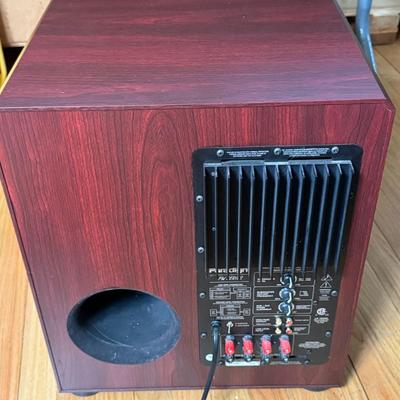
Sound Loud, clean and taut bass -- "can deliver 20Hz bass at levels in excess of 100dB"; external crossover is very transparent. Features Servo-controlled 15" driver; built-in 400W amplifier; external active crossover/controller with phase adjustment; can be purchased with internal crossover too. Use Three high-pass adjustments -- 50Hz, 80Hz and 120Hz -- as well as phase should make it easy to get good results with different speakers in different rooms. Value A lot of technology for $1500; can truly boast significant bang-for-the-buck! There aren’t many components that can access the audio reviewer’s inner-child with greater vigor and rapidity than a big baaaad subwoofer. I am very proud of myself for resisting the urge (most of the time!) to crank the gain of the Servo-15 to unduly exaggerated and punishing levels -- such levels proved to be more punishing for other household members then for myself. Although my listening room is set up in a finished basement, it is my understanding that some extraneous rattles and buzzes were happening up on the main floor and made my poor wife feel somewhat ill at ease. In fact, on at least one occasion I heard her make a hasty retreat from the epicenter at Rancho de Paco (our humble abode) shortly after the tremors began. 37 / 167 -
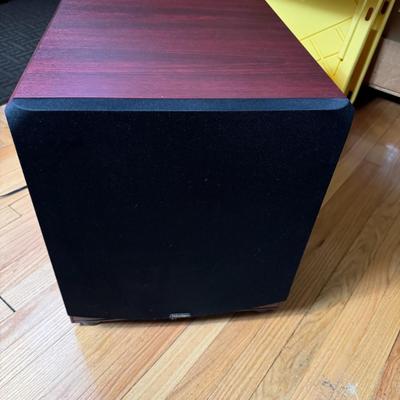
Sound Loud, clean and taut bass -- "can deliver 20Hz bass at levels in excess of 100dB"; external crossover is very transparent. Features Servo-controlled 15" driver; built-in 400W amplifier; external active crossover/controller with phase adjustment; can be purchased with internal crossover too. Use Three high-pass adjustments -- 50Hz, 80Hz and 120Hz -- as well as phase should make it easy to get good results with different speakers in different rooms. Value A lot of technology for $1500; can truly boast significant bang-for-the-buck! There aren’t many components that can access the audio reviewer’s inner-child with greater vigor and rapidity than a big baaaad subwoofer. I am very proud of myself for resisting the urge (most of the time!) to crank the gain of the Servo-15 to unduly exaggerated and punishing levels -- such levels proved to be more punishing for other household members then for myself. Although my listening room is set up in a finished basement, it is my understanding that some extraneous rattles and buzzes were happening up on the main floor and made my poor wife feel somewhat ill at ease. In fact, on at least one occasion I heard her make a hasty retreat from the epicenter at Rancho de Paco (our humble abode) shortly after the tremors began. 38 / 167 -
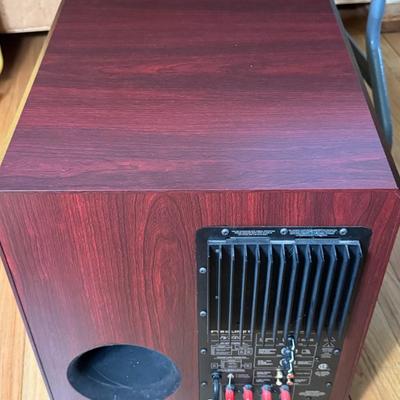
Sound Loud, clean and taut bass -- "can deliver 20Hz bass at levels in excess of 100dB"; external crossover is very transparent. Features Servo-controlled 15" driver; built-in 400W amplifier; external active crossover/controller with phase adjustment; can be purchased with internal crossover too. Use Three high-pass adjustments -- 50Hz, 80Hz and 120Hz -- as well as phase should make it easy to get good results with different speakers in different rooms. Value A lot of technology for $1500; can truly boast significant bang-for-the-buck! There aren’t many components that can access the audio reviewer’s inner-child with greater vigor and rapidity than a big baaaad subwoofer. I am very proud of myself for resisting the urge (most of the time!) to crank the gain of the Servo-15 to unduly exaggerated and punishing levels -- such levels proved to be more punishing for other household members then for myself. Although my listening room is set up in a finished basement, it is my understanding that some extraneous rattles and buzzes were happening up on the main floor and made my poor wife feel somewhat ill at ease. In fact, on at least one occasion I heard her make a hasty retreat from the epicenter at Rancho de Paco (our humble abode) shortly after the tremors began. 39 / 167 -
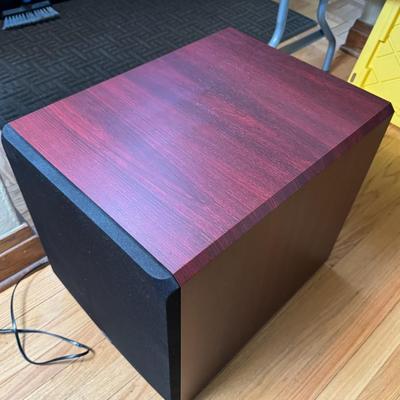
Sound Loud, clean and taut bass -- "can deliver 20Hz bass at levels in excess of 100dB"; external crossover is very transparent. Features Servo-controlled 15" driver; built-in 400W amplifier; external active crossover/controller with phase adjustment; can be purchased with internal crossover too. Use Three high-pass adjustments -- 50Hz, 80Hz and 120Hz -- as well as phase should make it easy to get good results with different speakers in different rooms. Value A lot of technology for $1500; can truly boast significant bang-for-the-buck! There aren’t many components that can access the audio reviewer’s inner-child with greater vigor and rapidity than a big baaaad subwoofer. I am very proud of myself for resisting the urge (most of the time!) to crank the gain of the Servo-15 to unduly exaggerated and punishing levels -- such levels proved to be more punishing for other household members then for myself. Although my listening room is set up in a finished basement, it is my understanding that some extraneous rattles and buzzes were happening up on the main floor and made my poor wife feel somewhat ill at ease. In fact, on at least one occasion I heard her make a hasty retreat from the epicenter at Rancho de Paco (our humble abode) shortly after the tremors began. 40 / 167 -
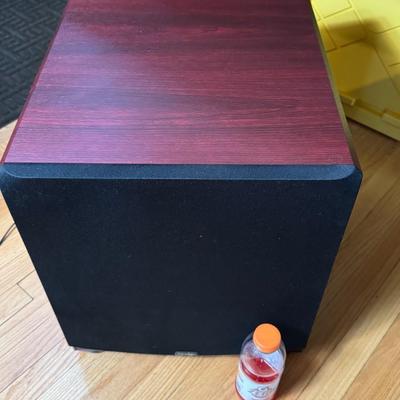
Sound Loud, clean and taut bass -- "can deliver 20Hz bass at levels in excess of 100dB"; external crossover is very transparent. Features Servo-controlled 15" driver; built-in 400W amplifier; external active crossover/controller with phase adjustment; can be purchased with internal crossover too. Use Three high-pass adjustments -- 50Hz, 80Hz and 120Hz -- as well as phase should make it easy to get good results with different speakers in different rooms. Value A lot of technology for $1500; can truly boast significant bang-for-the-buck! There aren’t many components that can access the audio reviewer’s inner-child with greater vigor and rapidity than a big baaaad subwoofer. I am very proud of myself for resisting the urge (most of the time!) to crank the gain of the Servo-15 to unduly exaggerated and punishing levels -- such levels proved to be more punishing for other household members then for myself. Although my listening room is set up in a finished basement, it is my understanding that some extraneous rattles and buzzes were happening up on the main floor and made my poor wife feel somewhat ill at ease. In fact, on at least one occasion I heard her make a hasty retreat from the epicenter at Rancho de Paco (our humble abode) shortly after the tremors began. 41 / 167 -
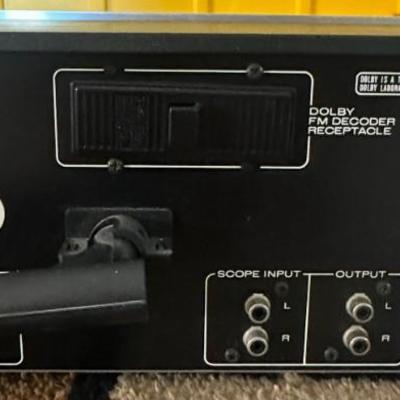
Specifications Type: Mono/Stereo Tuner Tuning Bands: FM, MW Tuning Scale: Analogue FM Tuning Range: 87.4 to 109 MHz MW Tuning Range: 515 to 1650 kHz Sensitivity: 1.1uV (FM), 15uV (MW) Signal to Noise Ratio: 72dB (FM), 50dB (MW) Distortion: 0.15% (FM), 0.4% (MW) Selectivity: 80dB (FM), 26dB (MW) Frequency response: 30Hz to 15kHz (FM), 40Hz to 2.2kHz (MW) Output: 700mV (FM) Semiconductors: 14 x IC, 57 x transistors, 44 x diodes, 11 x FET Dimensions: 416 x 146 x 301mm Weight: 9kg 42 / 167 -

Specifications Type: Mono/Stereo Tuner Tuning Bands: FM, MW Tuning Scale: Analogue FM Tuning Range: 87.4 to 109 MHz MW Tuning Range: 515 to 1650 kHz Sensitivity: 1.1uV (FM), 15uV (MW) Signal to Noise Ratio: 72dB (FM), 50dB (MW) Distortion: 0.15% (FM), 0.4% (MW) Selectivity: 80dB (FM), 26dB (MW) Frequency response: 30Hz to 15kHz (FM), 40Hz to 2.2kHz (MW) Output: 700mV (FM) Semiconductors: 14 x IC, 57 x transistors, 44 x diodes, 11 x FET Dimensions: 416 x 146 x 301mm Weight: 9kg 43 / 167 -
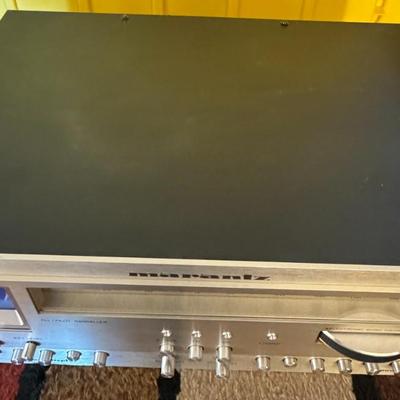
Specifications Type: Mono/Stereo Tuner Tuning Bands: FM, MW Tuning Scale: Analogue FM Tuning Range: 87.4 to 109 MHz MW Tuning Range: 515 to 1650 kHz Sensitivity: 1.1uV (FM), 15uV (MW) Signal to Noise Ratio: 72dB (FM), 50dB (MW) Distortion: 0.15% (FM), 0.4% (MW) Selectivity: 80dB (FM), 26dB (MW) Frequency response: 30Hz to 15kHz (FM), 40Hz to 2.2kHz (MW) Output: 700mV (FM) Semiconductors: 14 x IC, 57 x transistors, 44 x diodes, 11 x FET Dimensions: 416 x 146 x 301mm Weight: 9kg 44 / 167 -
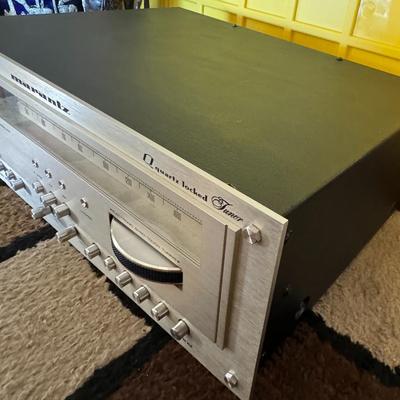
Specifications Type: Mono/Stereo Tuner Tuning Bands: FM, MW Tuning Scale: Analogue FM Tuning Range: 87.4 to 109 MHz MW Tuning Range: 515 to 1650 kHz Sensitivity: 1.1uV (FM), 15uV (MW) Signal to Noise Ratio: 72dB (FM), 50dB (MW) Distortion: 0.15% (FM), 0.4% (MW) Selectivity: 80dB (FM), 26dB (MW) Frequency response: 30Hz to 15kHz (FM), 40Hz to 2.2kHz (MW) Output: 700mV (FM) Semiconductors: 14 x IC, 57 x transistors, 44 x diodes, 11 x FET Dimensions: 416 x 146 x 301mm Weight: 9kg 45 / 167 -
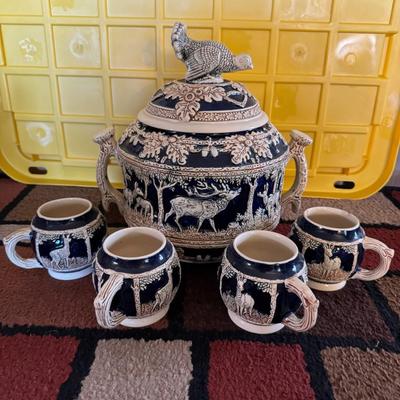
I AM OFFERING THIS WONDERFUL RARE VINTAGE "MARZI & REMI" GERMAN STONEWARE TURKEY CIDER/WINE/PUNCH TUREEN & LID! THE QUALITY AND DETAIL ARE EXQUISITE! THIS PIECE IS ABSOLUTELY STUNNING FEATURING AN AMAZING COBALT & TAN COLORING WITH A DESIGN OF STAG/DEER & LEAVES AND ACORNS WITH A TURKEY ON THE LID! SO SO BEAUTIFUL! YOU WILL LOVE THIS TUREEN! I HAVE BEEN TOLD THIS PIECE WITH THE TURKEY LID IS VARY HARD TO FIND. THIS TUREEN WOULD BE PERFECT FOR SO MANY USES! THIS TUREEN IS QUITE SUBSTANTIAL WEIGHING APPROXIMATELY 8.16 POUNDS AND IS AN IMPRESSIVE SIZE MEASURING APPROXIMATELY 12 1/4" TALL TO THE TOP OF THE TURKEY x 12" HANDLE TO HANDLE WITH THE TOP OPENING MEASURING APPROXIMATELY 6". THE BASE IS SIGNED AS SHOWN IN MY PHOTOS. PLEASE REFER TO MY PHOTOS AS THIS IS THE EXACT ITEM YOU WILL RECEIVE. I NEVER USE STOCK PHOTOS. YOU WILL NOT BE DISAPPOINTED WITH THIS EXCELLENT WONDERFUL RARE VINTAGE "MARZI & REMI" GERMAN STONEWARE TURKEY CIDER/WINE/PUNCH TUREEN & LID! THIS LOVELY PIECE WILL MAKE A WONDERFUL ADDITION TO YOUR "MARZI & REMI" GERMAN STONEWARE COLLECTION OR WILL MAKE A STATEMENT IN YOUR FINE ENTERTAINING! I SHIP UPS OR FED EX DEPENDING ON COST. INCLUDES INSURANCE AND TRACKING. I SHIP WITHIN THREE BUSINESS DAYS AFTER PAYMENT IS RECEIVED SO YOU WILL RECEIVE YOUR PURCHASE FAST! I WILL BE HAPPY TO SHIP INTERNATIONAL. INTERNATIONAL BUYERS PLEASE EMAIL FOR SHIPPING COSTS. I WILL CAREFULLY PACKAGE YOUR WONDERFUL RARE VINTAGE "MARZI & REMI" GERMAN STONEWARE TURKEY CIDER/WINE/PUNCH TUREEN & LID IN BUBBLE AND STYROFOAM PEANUTS. THANK YOU FOR LOOKING AND PLEASE FEEL FREE TO EMAIL WITH ANY QUESTIONS. 49 / 167 -

I AM OFFERING THIS WONDERFUL RARE VINTAGE "MARZI & REMI" GERMAN STONEWARE TURKEY CIDER/WINE/PUNCH TUREEN & LID! THE QUALITY AND DETAIL ARE EXQUISITE! THIS PIECE IS ABSOLUTELY STUNNING FEATURING AN AMAZING COBALT & TAN COLORING WITH A DESIGN OF STAG/DEER & LEAVES AND ACORNS WITH A TURKEY ON THE LID! SO SO BEAUTIFUL! YOU WILL LOVE THIS TUREEN! I HAVE BEEN TOLD THIS PIECE WITH THE TURKEY LID IS VARY HARD TO FIND. THIS TUREEN WOULD BE PERFECT FOR SO MANY USES! THIS TUREEN IS QUITE SUBSTANTIAL WEIGHING APPROXIMATELY 8.16 POUNDS AND IS AN IMPRESSIVE SIZE MEASURING APPROXIMATELY 12 1/4" TALL TO THE TOP OF THE TURKEY x 12" HANDLE TO HANDLE WITH THE TOP OPENING MEASURING APPROXIMATELY 6". THE BASE IS SIGNED AS SHOWN IN MY PHOTOS. PLEASE REFER TO MY PHOTOS AS THIS IS THE EXACT ITEM YOU WILL RECEIVE. I NEVER USE STOCK PHOTOS. YOU WILL NOT BE DISAPPOINTED WITH THIS EXCELLENT WONDERFUL RARE VINTAGE "MARZI & REMI" GERMAN STONEWARE TURKEY CIDER/WINE/PUNCH TUREEN & LID! THIS LOVELY PIECE WILL MAKE A WONDERFUL ADDITION TO YOUR "MARZI & REMI" GERMAN STONEWARE COLLECTION OR WILL MAKE A STATEMENT IN YOUR FINE ENTERTAINING! I SHIP UPS OR FED EX DEPENDING ON COST. INCLUDES INSURANCE AND TRACKING. I SHIP WITHIN THREE BUSINESS DAYS AFTER PAYMENT IS RECEIVED SO YOU WILL RECEIVE YOUR PURCHASE FAST! I WILL BE HAPPY TO SHIP INTERNATIONAL. INTERNATIONAL BUYERS PLEASE EMAIL FOR SHIPPING COSTS. I WILL CAREFULLY PACKAGE YOUR WONDERFUL RARE VINTAGE "MARZI & REMI" GERMAN STONEWARE TURKEY CIDER/WINE/PUNCH TUREEN & LID IN BUBBLE AND STYROFOAM PEANUTS. THANK YOU FOR LOOKING AND PLEASE FEEL FREE TO EMAIL WITH ANY QUESTIONS. 50 / 167 -
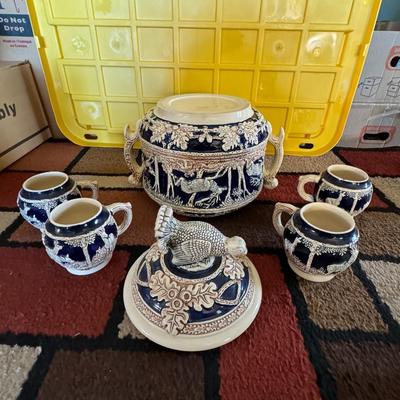
I AM OFFERING THIS WONDERFUL RARE VINTAGE "MARZI & REMI" GERMAN STONEWARE TURKEY CIDER/WINE/PUNCH TUREEN & LID! THE QUALITY AND DETAIL ARE EXQUISITE! THIS PIECE IS ABSOLUTELY STUNNING FEATURING AN AMAZING COBALT & TAN COLORING WITH A DESIGN OF STAG/DEER & LEAVES AND ACORNS WITH A TURKEY ON THE LID! SO SO BEAUTIFUL! YOU WILL LOVE THIS TUREEN! I HAVE BEEN TOLD THIS PIECE WITH THE TURKEY LID IS VARY HARD TO FIND. THIS TUREEN WOULD BE PERFECT FOR SO MANY USES! THIS TUREEN IS QUITE SUBSTANTIAL WEIGHING APPROXIMATELY 8.16 POUNDS AND IS AN IMPRESSIVE SIZE MEASURING APPROXIMATELY 12 1/4" TALL TO THE TOP OF THE TURKEY x 12" HANDLE TO HANDLE WITH THE TOP OPENING MEASURING APPROXIMATELY 6". THE BASE IS SIGNED AS SHOWN IN MY PHOTOS. PLEASE REFER TO MY PHOTOS AS THIS IS THE EXACT ITEM YOU WILL RECEIVE. I NEVER USE STOCK PHOTOS. YOU WILL NOT BE DISAPPOINTED WITH THIS EXCELLENT WONDERFUL RARE VINTAGE "MARZI & REMI" GERMAN STONEWARE TURKEY CIDER/WINE/PUNCH TUREEN & LID! THIS LOVELY PIECE WILL MAKE A WONDERFUL ADDITION TO YOUR "MARZI & REMI" GERMAN STONEWARE COLLECTION OR WILL MAKE A STATEMENT IN YOUR FINE ENTERTAINING! I SHIP UPS OR FED EX DEPENDING ON COST. INCLUDES INSURANCE AND TRACKING. I SHIP WITHIN THREE BUSINESS DAYS AFTER PAYMENT IS RECEIVED SO YOU WILL RECEIVE YOUR PURCHASE FAST! I WILL BE HAPPY TO SHIP INTERNATIONAL. INTERNATIONAL BUYERS PLEASE EMAIL FOR SHIPPING COSTS. I WILL CAREFULLY PACKAGE YOUR WONDERFUL RARE VINTAGE "MARZI & REMI" GERMAN STONEWARE TURKEY CIDER/WINE/PUNCH TUREEN & LID IN BUBBLE AND STYROFOAM PEANUTS. THANK YOU FOR LOOKING AND PLEASE FEEL FREE TO EMAIL WITH ANY QUESTIONS. 51 / 167 -
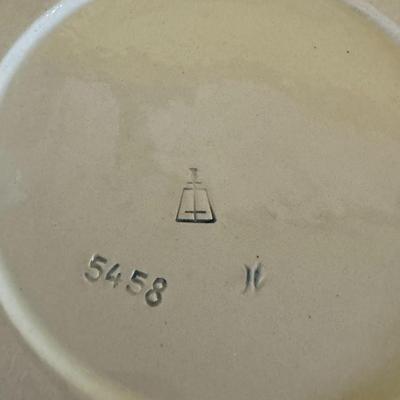
I AM OFFERING THIS WONDERFUL RARE VINTAGE "MARZI & REMI" GERMAN STONEWARE TURKEY CIDER/WINE/PUNCH TUREEN & LID! THE QUALITY AND DETAIL ARE EXQUISITE! THIS PIECE IS ABSOLUTELY STUNNING FEATURING AN AMAZING COBALT & TAN COLORING WITH A DESIGN OF STAG/DEER & LEAVES AND ACORNS WITH A TURKEY ON THE LID! SO SO BEAUTIFUL! YOU WILL LOVE THIS TUREEN! I HAVE BEEN TOLD THIS PIECE WITH THE TURKEY LID IS VARY HARD TO FIND. THIS TUREEN WOULD BE PERFECT FOR SO MANY USES! THIS TUREEN IS QUITE SUBSTANTIAL WEIGHING APPROXIMATELY 8.16 POUNDS AND IS AN IMPRESSIVE SIZE MEASURING APPROXIMATELY 12 1/4" TALL TO THE TOP OF THE TURKEY x 12" HANDLE TO HANDLE WITH THE TOP OPENING MEASURING APPROXIMATELY 6". THE BASE IS SIGNED AS SHOWN IN MY PHOTOS. PLEASE REFER TO MY PHOTOS AS THIS IS THE EXACT ITEM YOU WILL RECEIVE. I NEVER USE STOCK PHOTOS. YOU WILL NOT BE DISAPPOINTED WITH THIS EXCELLENT WONDERFUL RARE VINTAGE "MARZI & REMI" GERMAN STONEWARE TURKEY CIDER/WINE/PUNCH TUREEN & LID! THIS LOVELY PIECE WILL MAKE A WONDERFUL ADDITION TO YOUR "MARZI & REMI" GERMAN STONEWARE COLLECTION OR WILL MAKE A STATEMENT IN YOUR FINE ENTERTAINING! I SHIP UPS OR FED EX DEPENDING ON COST. INCLUDES INSURANCE AND TRACKING. I SHIP WITHIN THREE BUSINESS DAYS AFTER PAYMENT IS RECEIVED SO YOU WILL RECEIVE YOUR PURCHASE FAST! I WILL BE HAPPY TO SHIP INTERNATIONAL. INTERNATIONAL BUYERS PLEASE EMAIL FOR SHIPPING COSTS. I WILL CAREFULLY PACKAGE YOUR WONDERFUL RARE VINTAGE "MARZI & REMI" GERMAN STONEWARE TURKEY CIDER/WINE/PUNCH TUREEN & LID IN BUBBLE AND STYROFOAM PEANUTS. THANK YOU FOR LOOKING AND PLEASE FEEL FREE TO EMAIL WITH ANY QUESTIONS. 52 / 167 -
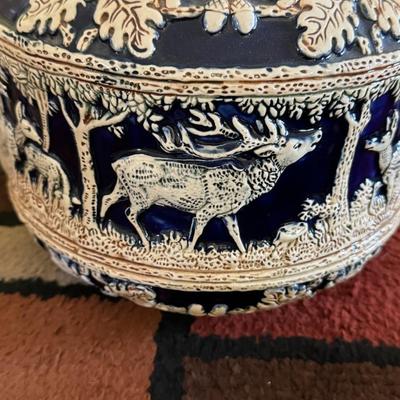
I AM OFFERING THIS WONDERFUL RARE VINTAGE "MARZI & REMI" GERMAN STONEWARE TURKEY CIDER/WINE/PUNCH TUREEN & LID! THE QUALITY AND DETAIL ARE EXQUISITE! THIS PIECE IS ABSOLUTELY STUNNING FEATURING AN AMAZING COBALT & TAN COLORING WITH A DESIGN OF STAG/DEER & LEAVES AND ACORNS WITH A TURKEY ON THE LID! SO SO BEAUTIFUL! YOU WILL LOVE THIS TUREEN! I HAVE BEEN TOLD THIS PIECE WITH THE TURKEY LID IS VARY HARD TO FIND. THIS TUREEN WOULD BE PERFECT FOR SO MANY USES! THIS TUREEN IS QUITE SUBSTANTIAL WEIGHING APPROXIMATELY 8.16 POUNDS AND IS AN IMPRESSIVE SIZE MEASURING APPROXIMATELY 12 1/4" TALL TO THE TOP OF THE TURKEY x 12" HANDLE TO HANDLE WITH THE TOP OPENING MEASURING APPROXIMATELY 6". THE BASE IS SIGNED AS SHOWN IN MY PHOTOS. PLEASE REFER TO MY PHOTOS AS THIS IS THE EXACT ITEM YOU WILL RECEIVE. I NEVER USE STOCK PHOTOS. YOU WILL NOT BE DISAPPOINTED WITH THIS EXCELLENT WONDERFUL RARE VINTAGE "MARZI & REMI" GERMAN STONEWARE TURKEY CIDER/WINE/PUNCH TUREEN & LID! THIS LOVELY PIECE WILL MAKE A WONDERFUL ADDITION TO YOUR "MARZI & REMI" GERMAN STONEWARE COLLECTION OR WILL MAKE A STATEMENT IN YOUR FINE ENTERTAINING! I SHIP UPS OR FED EX DEPENDING ON COST. INCLUDES INSURANCE AND TRACKING. I SHIP WITHIN THREE BUSINESS DAYS AFTER PAYMENT IS RECEIVED SO YOU WILL RECEIVE YOUR PURCHASE FAST! I WILL BE HAPPY TO SHIP INTERNATIONAL. INTERNATIONAL BUYERS PLEASE EMAIL FOR SHIPPING COSTS. I WILL CAREFULLY PACKAGE YOUR WONDERFUL RARE VINTAGE "MARZI & REMI" GERMAN STONEWARE TURKEY CIDER/WINE/PUNCH TUREEN & LID IN BUBBLE AND STYROFOAM PEANUTS. THANK YOU FOR LOOKING AND PLEASE FEEL FREE TO EMAIL WITH ANY QUESTIONS. 53 / 167 -
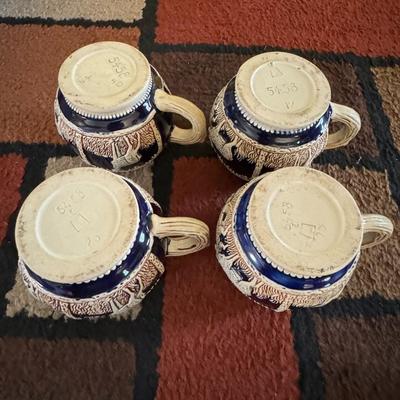
I AM OFFERING THIS WONDERFUL RARE VINTAGE "MARZI & REMI" GERMAN STONEWARE TURKEY CIDER/WINE/PUNCH TUREEN & LID! THE QUALITY AND DETAIL ARE EXQUISITE! THIS PIECE IS ABSOLUTELY STUNNING FEATURING AN AMAZING COBALT & TAN COLORING WITH A DESIGN OF STAG/DEER & LEAVES AND ACORNS WITH A TURKEY ON THE LID! SO SO BEAUTIFUL! YOU WILL LOVE THIS TUREEN! I HAVE BEEN TOLD THIS PIECE WITH THE TURKEY LID IS VARY HARD TO FIND. THIS TUREEN WOULD BE PERFECT FOR SO MANY USES! THIS TUREEN IS QUITE SUBSTANTIAL WEIGHING APPROXIMATELY 8.16 POUNDS AND IS AN IMPRESSIVE SIZE MEASURING APPROXIMATELY 12 1/4" TALL TO THE TOP OF THE TURKEY x 12" HANDLE TO HANDLE WITH THE TOP OPENING MEASURING APPROXIMATELY 6". THE BASE IS SIGNED AS SHOWN IN MY PHOTOS. PLEASE REFER TO MY PHOTOS AS THIS IS THE EXACT ITEM YOU WILL RECEIVE. I NEVER USE STOCK PHOTOS. YOU WILL NOT BE DISAPPOINTED WITH THIS EXCELLENT WONDERFUL RARE VINTAGE "MARZI & REMI" GERMAN STONEWARE TURKEY CIDER/WINE/PUNCH TUREEN & LID! THIS LOVELY PIECE WILL MAKE A WONDERFUL ADDITION TO YOUR "MARZI & REMI" GERMAN STONEWARE COLLECTION OR WILL MAKE A STATEMENT IN YOUR FINE ENTERTAINING! I SHIP UPS OR FED EX DEPENDING ON COST. INCLUDES INSURANCE AND TRACKING. I SHIP WITHIN THREE BUSINESS DAYS AFTER PAYMENT IS RECEIVED SO YOU WILL RECEIVE YOUR PURCHASE FAST! I WILL BE HAPPY TO SHIP INTERNATIONAL. INTERNATIONAL BUYERS PLEASE EMAIL FOR SHIPPING COSTS. I WILL CAREFULLY PACKAGE YOUR WONDERFUL RARE VINTAGE "MARZI & REMI" GERMAN STONEWARE TURKEY CIDER/WINE/PUNCH TUREEN & LID IN BUBBLE AND STYROFOAM PEANUTS. THANK YOU FOR LOOKING AND PLEASE FEEL FREE TO EMAIL WITH ANY QUESTIONS. 54 / 167 -
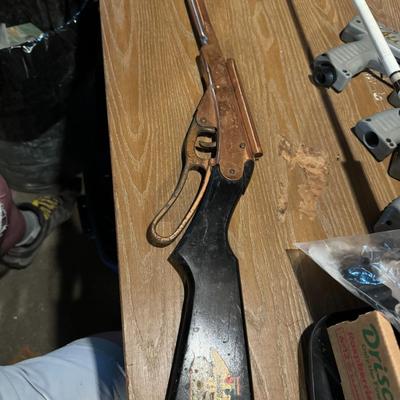
177 BB, very good smooth bore. This 50th Anniversary Commemorative BB rifle was sold from 1936 to 1938 and it remains in very good condition with about 75% bright copper plating on metal parts. The butstock decal shows a couple small scuffs and still has bright colors. Butstock has a repaired crack through wrist and shows typical wear and a former owners initials added to right side of wrist. Action works well, BB5 shoot out. The original tube peep sight and globe front sight remain in excellent condition. A classic prewar Daisy. 83 / 167 -
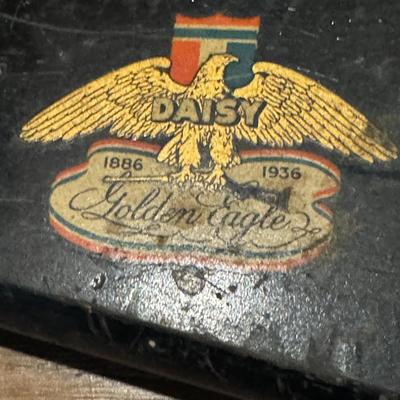
177 BB, very good smooth bore. This 50th Anniversary Commemorative BB rifle was sold from 1936 to 1938 and it remains in very good condition with about 75% bright copper plating on metal parts. The butstock decal shows a couple small scuffs and still has bright colors. Butstock has a repaired crack through wrist and shows typical wear and a former owners initials added to right side of wrist. Action works well, BB5 shoot out. The original tube peep sight and globe front sight remain in excellent condition. A classic prewar Daisy. 84 / 167 -
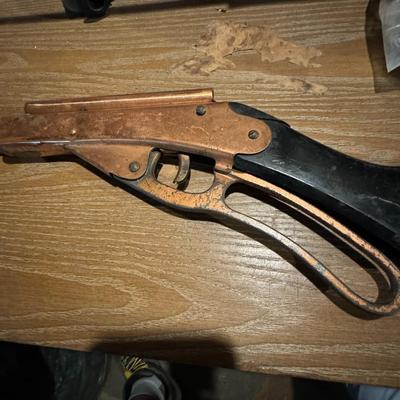
177 BB, very good smooth bore. This 50th Anniversary Commemorative BB rifle was sold from 1936 to 1938 and it remains in very good condition with about 75% bright copper plating on metal parts. The butstock decal shows a couple small scuffs and still has bright colors. Butstock has a repaired crack through wrist and shows typical wear and a former owners initials added to right side of wrist. Action works well, BB5 shoot out. The original tube peep sight and globe front sight remain in excellent condition. A classic prewar Daisy. 85 / 167 -
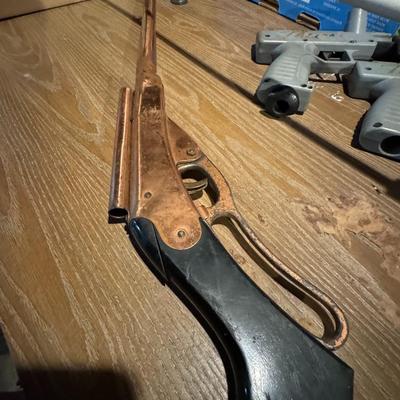
177 BB, very good smooth bore. This 50th Anniversary Commemorative BB rifle was sold from 1936 to 1938 and it remains in very good condition with about 75% bright copper plating on metal parts. The butstock decal shows a couple small scuffs and still has bright colors. Butstock has a repaired crack through wrist and shows typical wear and a former owners initials added to right side of wrist. Action works well, BB5 shoot out. The original tube peep sight and globe front sight remain in excellent condition. A classic prewar Daisy. 86 / 167 -
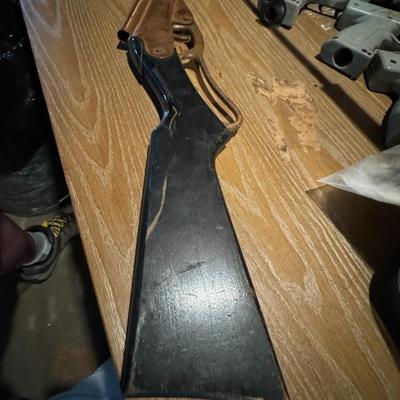
177 BB, very good smooth bore. This 50th Anniversary Commemorative BB rifle was sold from 1936 to 1938 and it remains in very good condition with about 75% bright copper plating on metal parts. The butstock decal shows a couple small scuffs and still has bright colors. Butstock has a repaired crack through wrist and shows typical wear and a former owners initials added to right side of wrist. Action works well, BB5 shoot out. The original tube peep sight and globe front sight remain in excellent condition. A classic prewar Daisy. 87 / 167 -
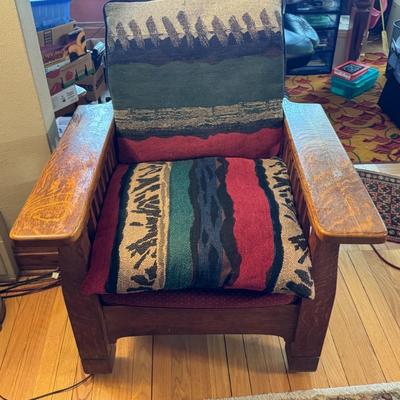
Morris style chairs feature a seat with a reclining back and moderately high armrests, which give the chair an old-style appearance. The characteristic feature of a Morris chair is a hinged back, set between two un-upholstered arms, with the reclining angle adjusted through a row of pegs, holes or notches in each arm. In other instances, the reclining of the back is controlled by a metal bar set in hooked back racks. The original Morris chair had dark stained woodwork, turned spindles and heavily decorated upholstery, in typical Victorian style. 88 / 167 -
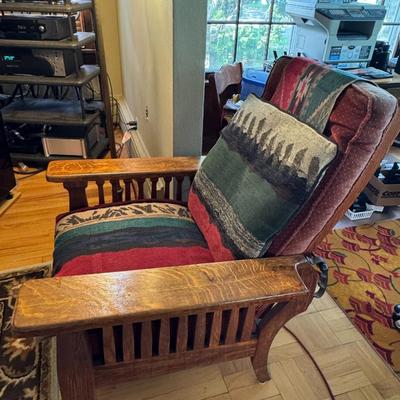
Morris style chairs feature a seat with a reclining back and moderately high armrests, which give the chair an old-style appearance. The characteristic feature of a Morris chair is a hinged back, set between two un-upholstered arms, with the reclining angle adjusted through a row of pegs, holes or notches in each arm. In other instances, the reclining of the back is controlled by a metal bar set in hooked back racks. The original Morris chair had dark stained woodwork, turned spindles and heavily decorated upholstery, in typical Victorian style. 89 / 167 -

Morris style chairs feature a seat with a reclining back and moderately high armrests, which give the chair an old-style appearance. The characteristic feature of a Morris chair is a hinged back, set between two un-upholstered arms, with the reclining angle adjusted through a row of pegs, holes or notches in each arm. In other instances, the reclining of the back is controlled by a metal bar set in hooked back racks. The original Morris chair had dark stained woodwork, turned spindles and heavily decorated upholstery, in typical Victorian style. 90 / 167 -
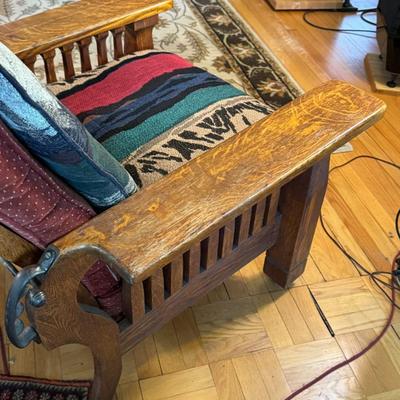
Morris style chairs feature a seat with a reclining back and moderately high armrests, which give the chair an old-style appearance. The characteristic feature of a Morris chair is a hinged back, set between two un-upholstered arms, with the reclining angle adjusted through a row of pegs, holes or notches in each arm. In other instances, the reclining of the back is controlled by a metal bar set in hooked back racks. The original Morris chair had dark stained woodwork, turned spindles and heavily decorated upholstery, in typical Victorian style. 91 / 167 -
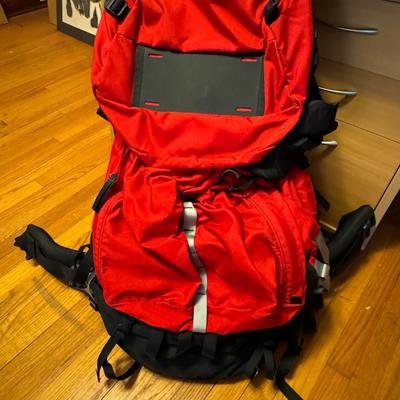
Made in Boseman, Montana. Heavy duty back packing and mountaineering pack. Size medium, approximately 18" - 20" torso length. Highly regarded for comfort carrying heavy loads. Features: - 5000 plus cubic inches capacity. - Suspension is 1 internal aluminum stay and frame sheet. Fiberglass rods run from the outside corners to the load lifter buckles. External padded back-panel. - Top lid pocket, main body and zippered lower sleeping bag compartments. Lid converts to a fanny pack. - External beaver tail shove-it pocket. - Extension/sealing skirt adds additional capacity when extended. - Side wand pockets. - Front of torso water bottle holder and small pocket. - Heavy duty Cordura pack cloth in green. The color is not faded. - Includes 1 unused strap-on front pouch for crampons, etc. There is a lid panel also for attaching crampons. Additional 500 cubic inches. - Daisy chains and ice axe loops. - Retractable bottom for carrying smaller loads. If you can find one of these, buy it!” one reviewer said. This bag is seriously impressive. Crazy capacity, audacious over-design, and the most compression straps we’ve ever seen. This bag is the real deal. For super long trips in the backcountry, this bag is your best friend. 92 / 167 -
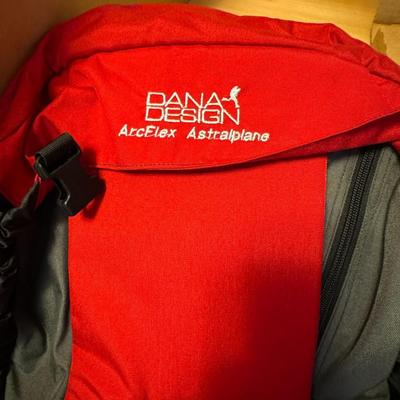
Made in Boseman, Montana. Heavy duty back packing and mountaineering pack. Size medium, approximately 18" - 20" torso length. Highly regarded for comfort carrying heavy loads. Features: - 5000 plus cubic inches capacity. - Suspension is 1 internal aluminum stay and frame sheet. Fiberglass rods run from the outside corners to the load lifter buckles. External padded back-panel. - Top lid pocket, main body and zippered lower sleeping bag compartments. Lid converts to a fanny pack. - External beaver tail shove-it pocket. - Extension/sealing skirt adds additional capacity when extended. - Side wand pockets. - Front of torso water bottle holder and small pocket. - Heavy duty Cordura pack cloth in green. The color is not faded. - Includes 1 unused strap-on front pouch for crampons, etc. There is a lid panel also for attaching crampons. Additional 500 cubic inches. - Daisy chains and ice axe loops. - Retractable bottom for carrying smaller loads. If you can find one of these, buy it!” one reviewer said. This bag is seriously impressive. Crazy capacity, audacious over-design, and the most compression straps we’ve ever seen. This bag is the real deal. For super long trips in the backcountry, this bag is your best friend. 93 / 167 -
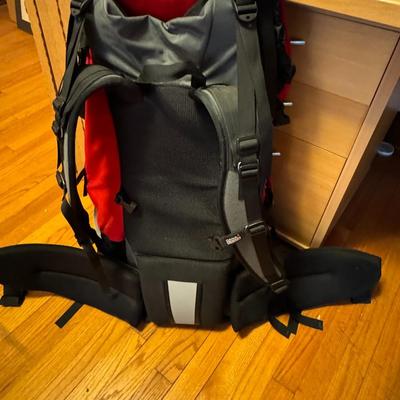
Made in Boseman, Montana. Heavy duty back packing and mountaineering pack. Size medium, approximately 18" - 20" torso length. Highly regarded for comfort carrying heavy loads. Features: - 5000 plus cubic inches capacity. - Suspension is 1 internal aluminum stay and frame sheet. Fiberglass rods run from the outside corners to the load lifter buckles. External padded back-panel. - Top lid pocket, main body and zippered lower sleeping bag compartments. Lid converts to a fanny pack. - External beaver tail shove-it pocket. - Extension/sealing skirt adds additional capacity when extended. - Side wand pockets. - Front of torso water bottle holder and small pocket. - Heavy duty Cordura pack cloth in green. The color is not faded. - Includes 1 unused strap-on front pouch for crampons, etc. There is a lid panel also for attaching crampons. Additional 500 cubic inches. - Daisy chains and ice axe loops. - Retractable bottom for carrying smaller loads. If you can find one of these, buy it!” one reviewer said. This bag is seriously impressive. Crazy capacity, audacious over-design, and the most compression straps we’ve ever seen. This bag is the real deal. For super long trips in the backcountry, this bag is your best friend. 94 / 167 -
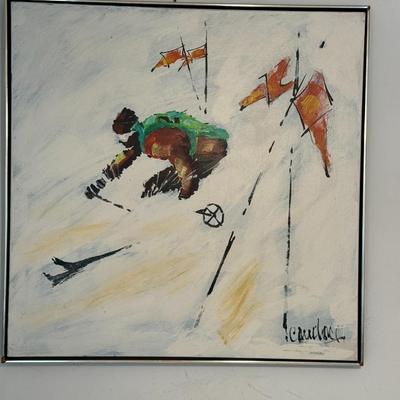
36" x 36" original framed art 95 / 167 -
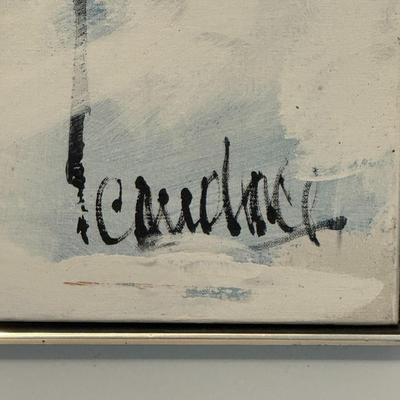
36" x 36" original framed art 96 / 167 -

36" x 36" original framed art 97 / 167 -
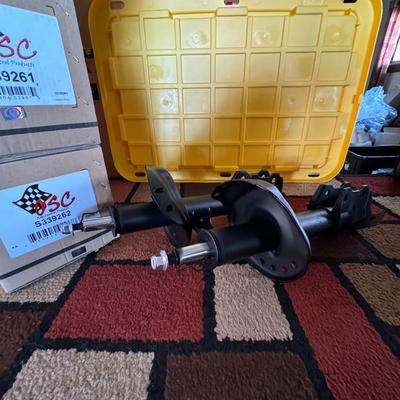
New OSC Honda CRV struts for 2007-2014 100 / 167
Photos 1 - 100 of 167
Per page:
